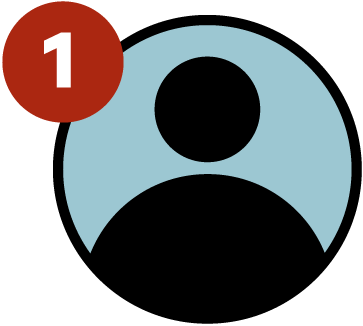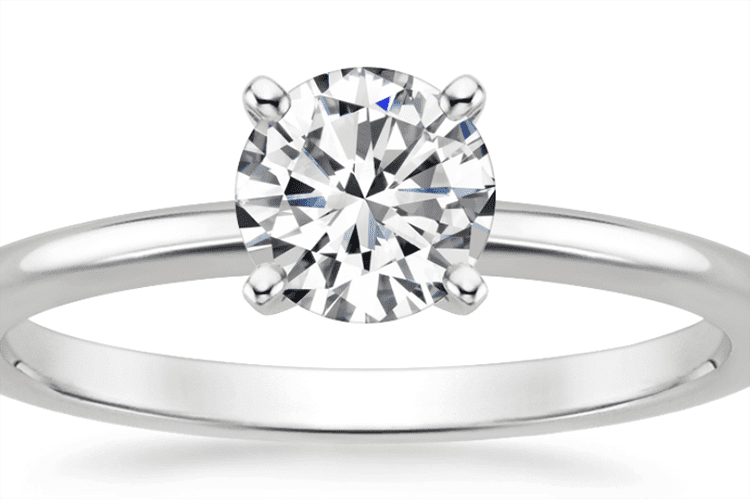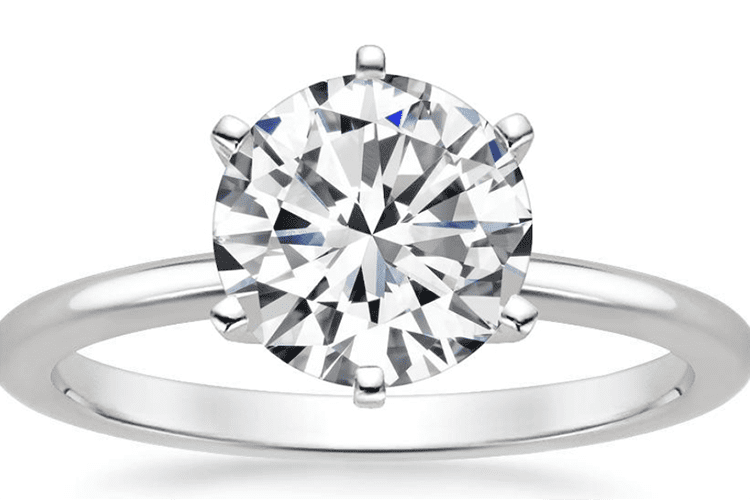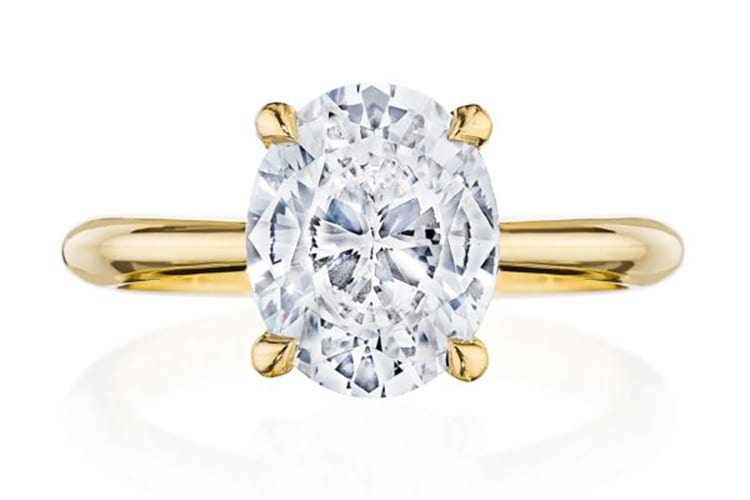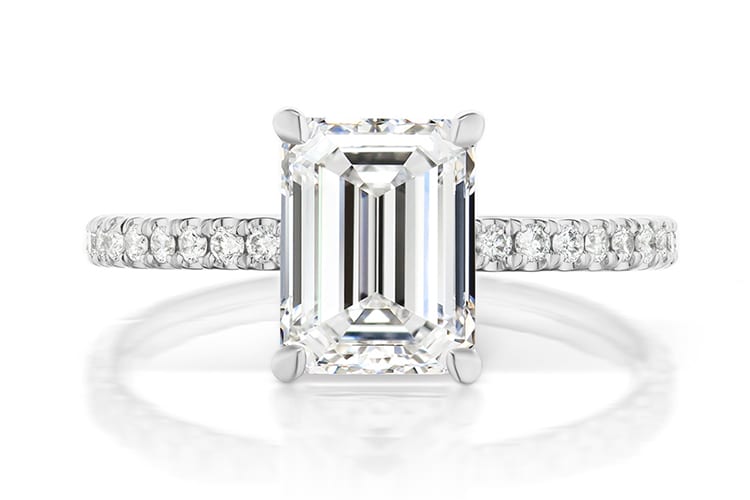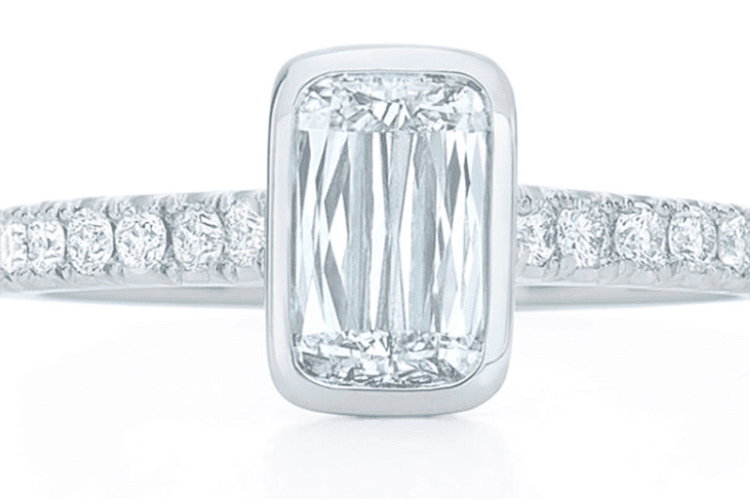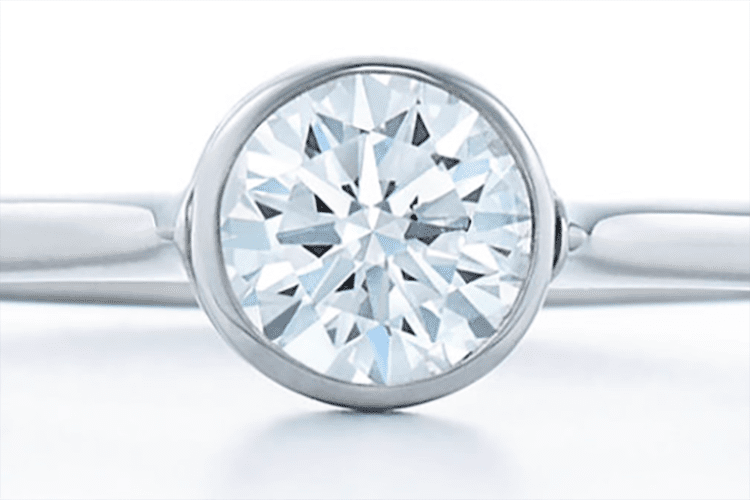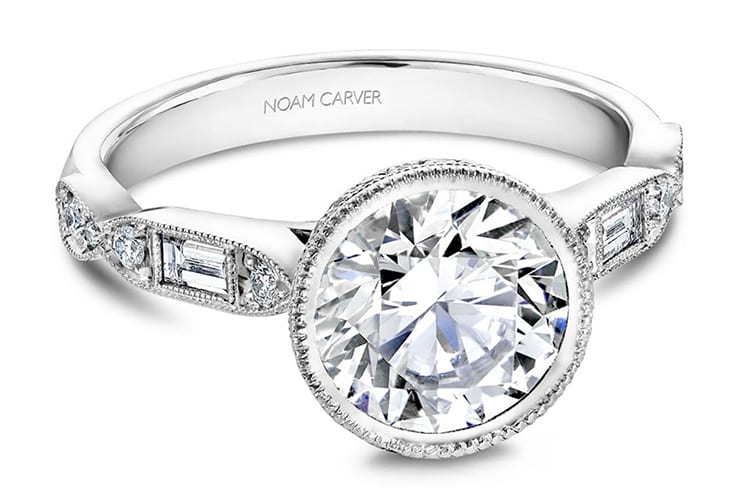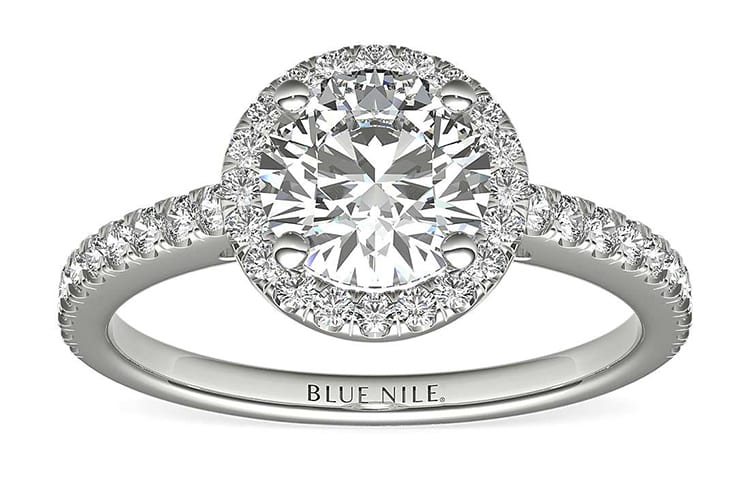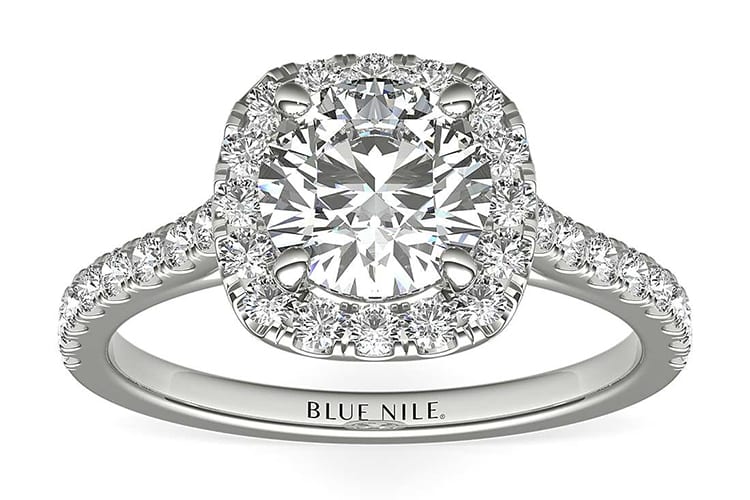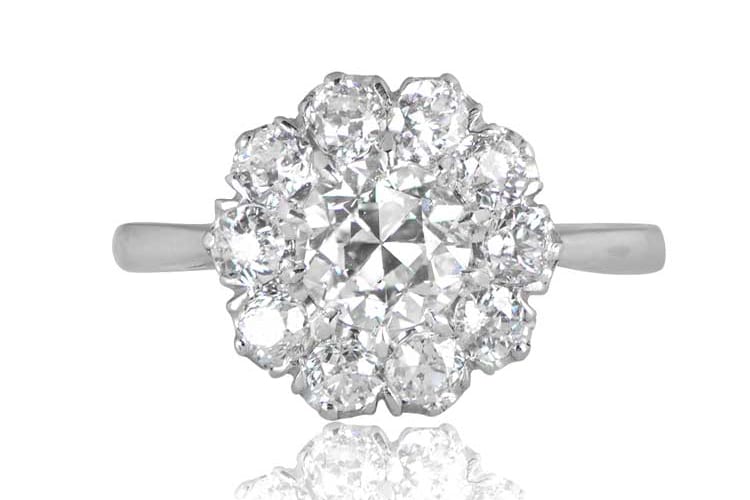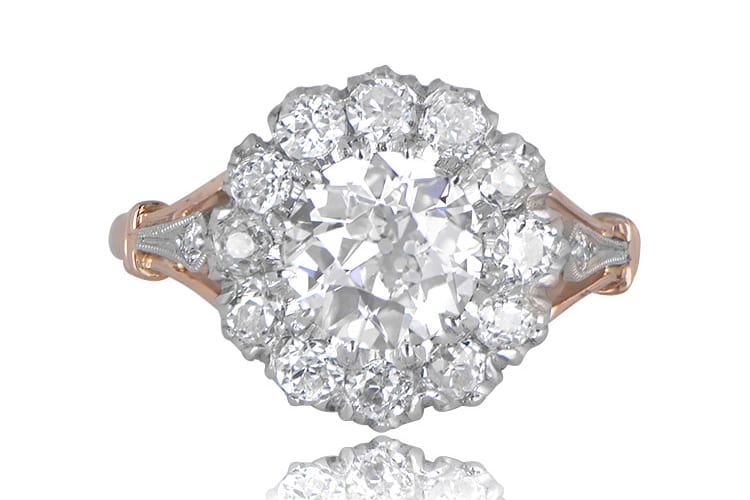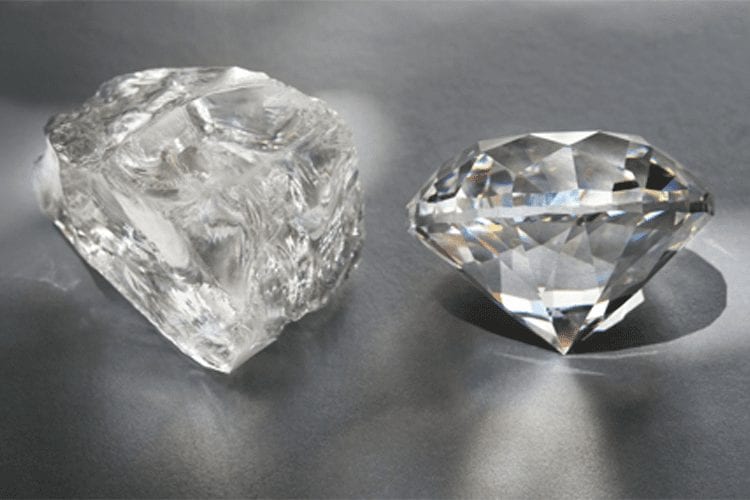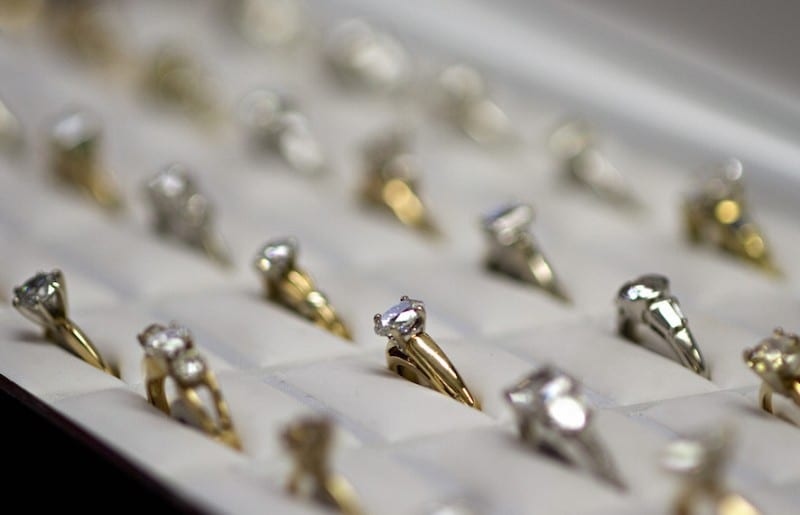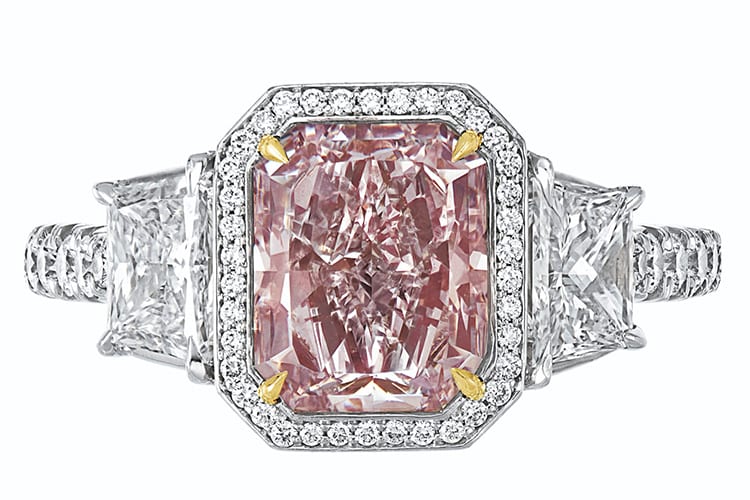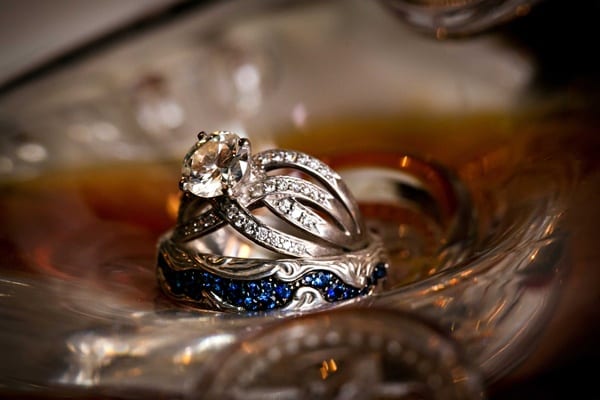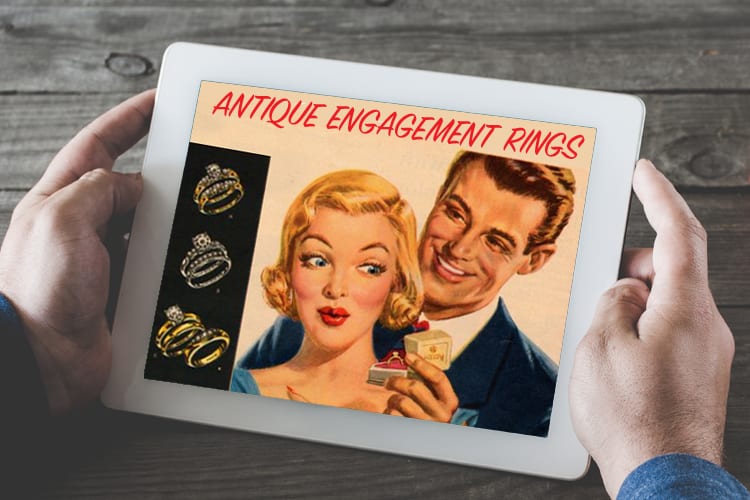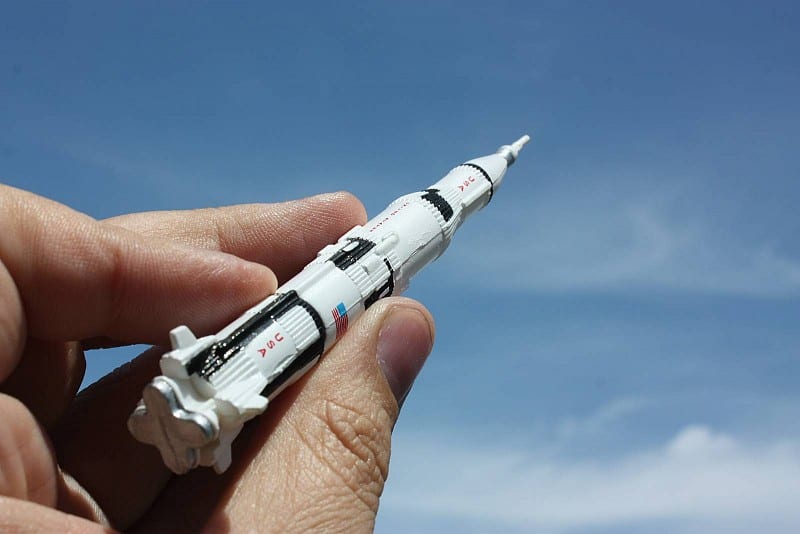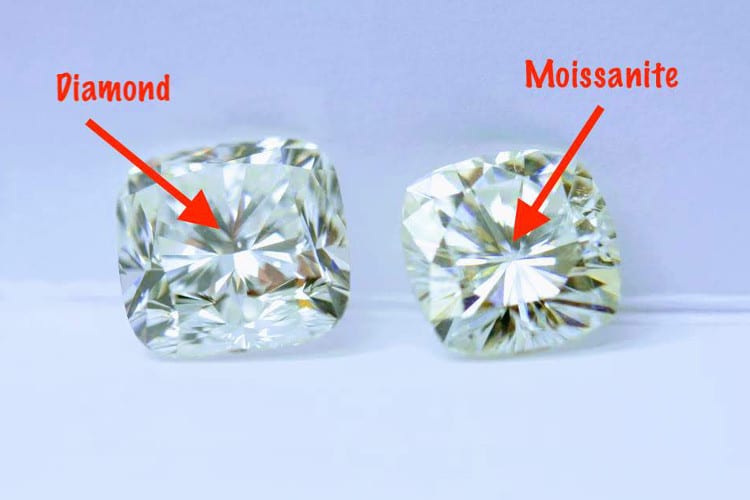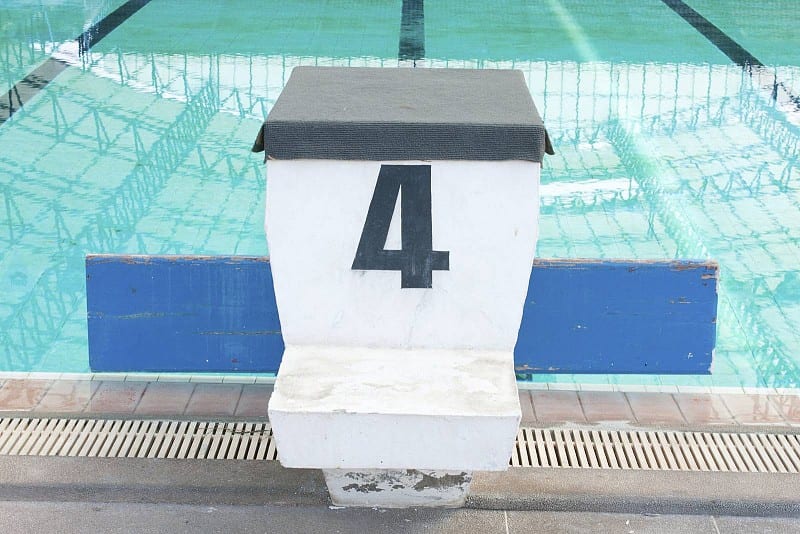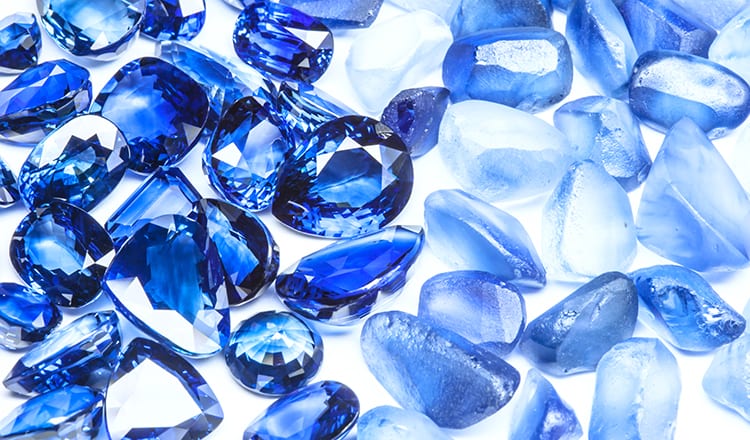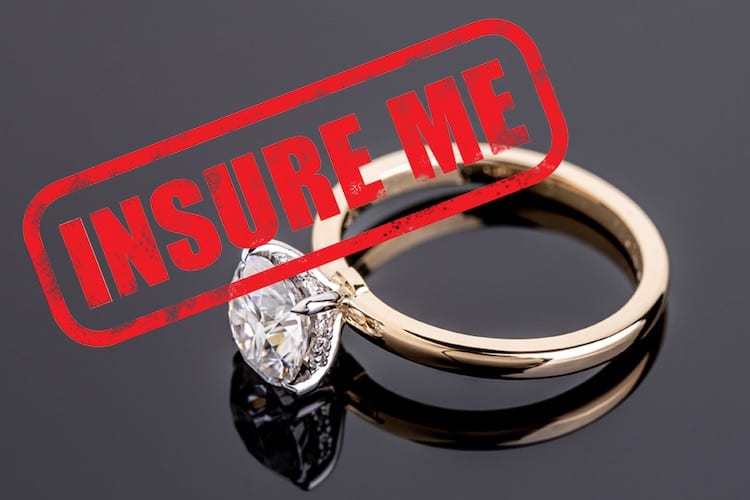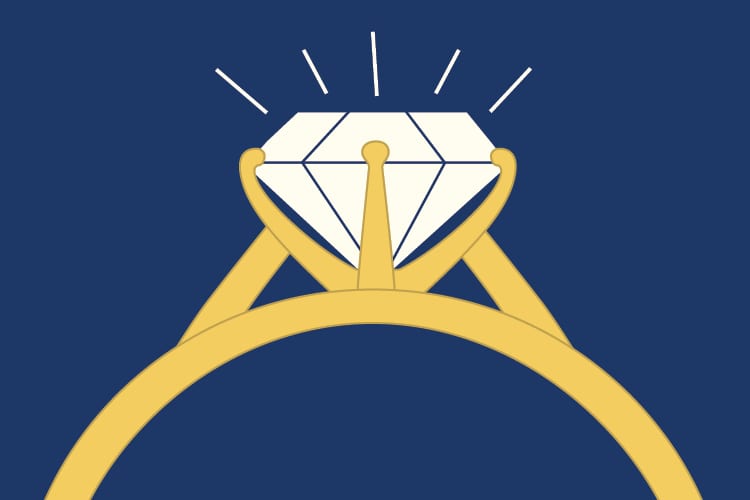
Everybody has advice about how to buy an engagement ring. The problem is, the tips are all over the map. On any given day, you could hear the following pronouncements:
- Start with a budget.
- Start with a ring style she would like.
- Start by browsing online.
- Start by visiting a local jeweler.
- Start by talking to her about the ring.
- Start by talking to her mom or sister.
No wonder we agonize. It’s like a high-stakes choose-your-own-adventure plot. So we’ll cut to the chase and declare the correct answer: Start by reading this Plunge Guide to Diamonds and Engagement Rings. Good idea.
Even if you have an idea of what you want to get your partner, you’ll want to understand the details about diamond carat size, ring settings, and the pros and cons of various metals. As you narrow down the options and look at many rings, destiny will guide you — it’s gotten you this far, hasn’t it? — and your budget is your reality check.
Nothing’s going to happen until you find trustworthy retailers — whether online or at brick-and-mortar stores (see more on this below). Get recommendations from friends who were thrilled with where they bought their rings. Ask your uncle Bill. Call your cousin in California. Look at some of the reviews on web sites that offer reviews. And if you’re purchasing a ring from a physical store (like a mall shop), ask as many questions as you can to build a relationship with the salespeople helping you and see if it’s a match. Where you purchase the ring has to fit as well as the ring fits your bride-to-be.
Tip: Some people buy the diamond first and then the setting (“build your own”). Others buy it all in one transaction or even the setting and then the diamond. Neither one is better than the other. You will see websites like James Allen (shown below) and Blue Nile asking you which approach you prefer.
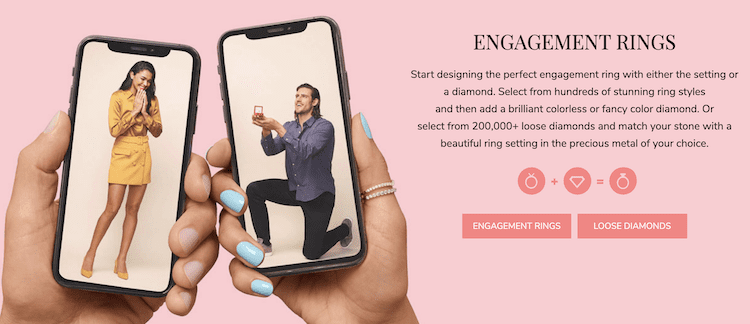
Even though I have decades of experience writing about diamonds and rings, I reached out to a few sources I trust to get their advice, specifically Afshin Shaddaie and Michael Khordipour, who penned the book The Engagement Ring Guide For Men. Together, they have 40 years’ experience in the jewelry industry helping men choose and design rings as a primary part of their business.
The 4Cs: Carats, Cut, Color, Clarity
We are all lured by larger diamonds. But in the diamond biz, bigger is not always better. Below, we share some tips on how to find the best stone for your partner — and not just the blingiest. You will be balancing four criteria: carat weight, cut, color and clarity. These are your friends. Say hello to the 4Cs.
Don’t be a sucker: Buy rings from trusted online sources James Allen, Whiteflash, and Blue Nile. You’re guaranteed to find better and more in-depth information thanks to their videos and listing details.
Diamond Carats
“The more carat weight, the more the value increases; however the other Cs have an impact on value as well,” explains Shaddaie. And not all diamonds are created equal when it comes to weight. “For example, Emerald cut diamonds look much larger than other diamonds of the same weight.”
Examples: James Allen sells a 1.04-carat emerald-cut diamond, with F color and SI1 clarity, for $3,444. Blue Nile sells a similar diamond (1.04 carats) with slightly better color (E) and the same SI1 clarity for $3,746. A different shaped diamond at the same carat weight might look smaller. And it could be less or more expensive based on those other 4Cs.
A related point: the larger the stone, the rarer it is. Two 1-carat stones will not cost as much as a 2-carat diamond, assuming the same quality.
Tip: Some sizes are considered to be magical in selling. Round numbers like 0.50, 0.75 and 1-carat, for example, are more understandable for most people, but can cost considerably more than slightly smaller weights such as 0.45, 0.70 and 0.95. The differences are imperceptible to the untrained eye, but you may be able to save money on your diamond. For more on the topic, see our diamond carat guide.
Visual example: The two rings below — both from James Allen — have the exact same grades across the board except for one thing: carats. One is 0.98 and the other is 1.01. You’d save $700 if you got the ring on the left. Will she care (or even know) if you get the 0.98 carat diamond?
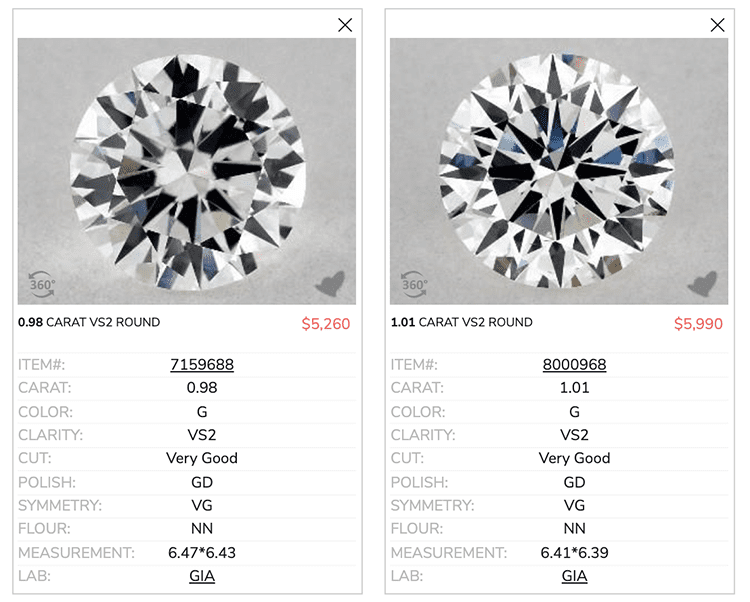
Here’s a look at how the carat sizes actually look on a real hand. By the way, a 7-carat stone will cost at least $65,000. And it could easily have worse grades than those one-carat beauties above.
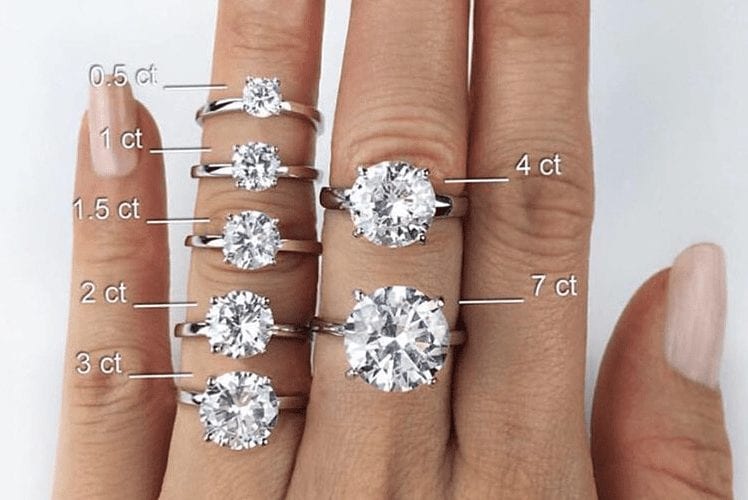
And below we show a visual guide to carat weight and millimeter width, which gets us back to reality and out of the abstract.
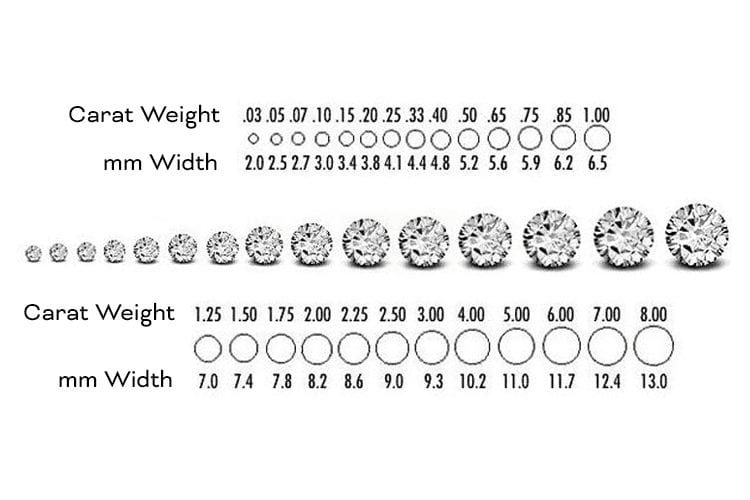
Diamond Cut
One thing that consistently confuses people is the fact that the shape of the diamond is not the same as its cut. We’ll explain all the shapes shortly. For now, think of cut as how masterfully the stone has been carved
The illustration below indicates what happens when diamonds are cut too shallow or too deep.
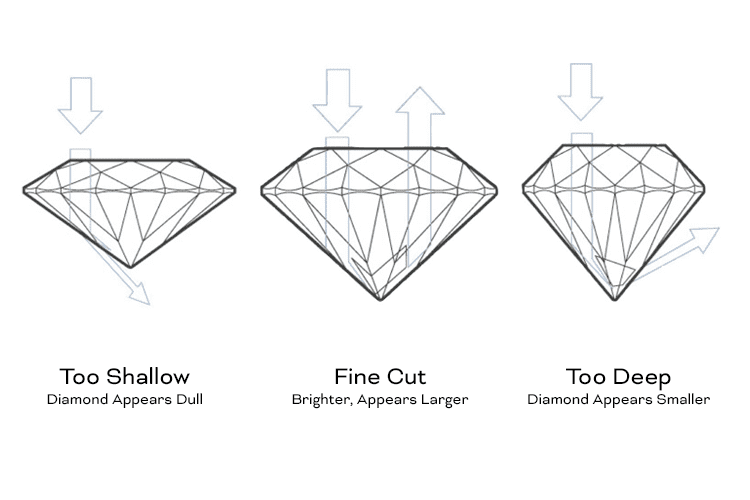
“A diamond’s cut is measured by its symmetry and polish,” says Shaddaie. Simply put, these aspects will determine the brilliance (white light) of the stone. A precise cut with the right proportions will produce the best fire, brightness, and scintillation (the sparkle of the diamond).
The GIA grades cuts as follows:
- Excellent
- Very Good
- Good
- Fair
- Poor
The cut has the most impact on a diamond’s appearance; therefore you might want to think about this first when looking, and then choose color and clarity. Also note that some sites don’t even offer diamonds that would get a poor or fair cut grading.
Tip: We suggest you go no lower than “good” cut.
For more on the topic, see our diamond cut guide.
Diamond Color
“When we talk about color, we are actually referring to the diamond’s lack of color in white diamonds,” says Shaddaie. There’s also a category of natural fancy colored diamonds, but these are rated completely differently and will only confuse you.
Bottom line: Color grade affects price. You can see it with your own eyes at James Allen , where you can literally spin the diamond around 360 degrees.
Diamonds are evaluated on a scale from D (colorless) to Z (light yellow or brown). “Diamonds from D to J, should appear colorless to the naked eye,” Shaddaie explains. For more on the topic, see our diamond color guide.
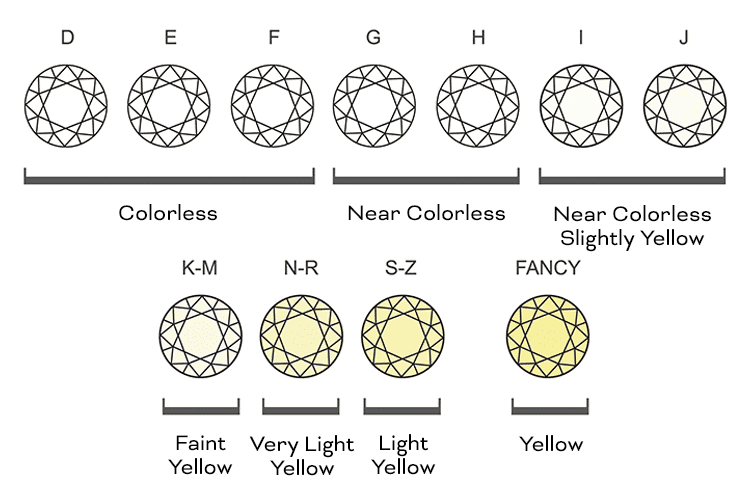
Visual example: Below are two rings sold at James Allen. Both are one carat large. The left diamond’s color is rated “I,” which is several grades lower than the second diamond’s “F.” They have the same clarity grade: VS1. The stone on the left costs $3,710 while the one on the right (with a much better color grade) costs $6,080. Eye-opening isn’t it?
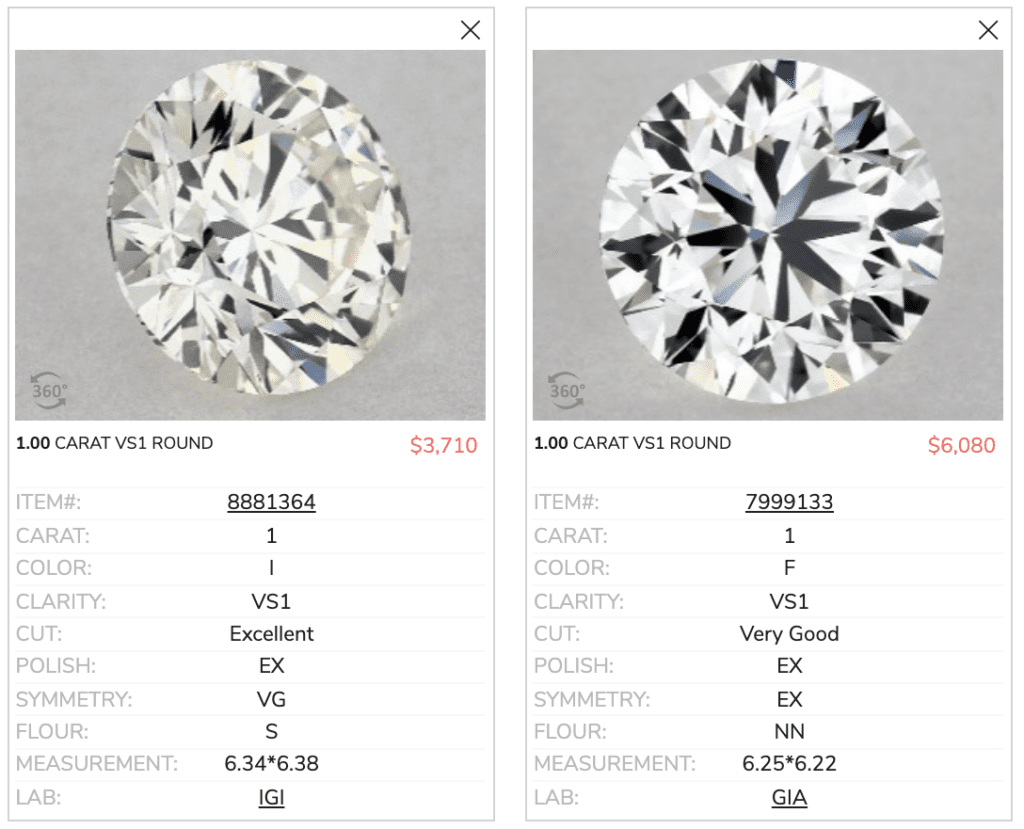
Other characteristics make a difference and affect the price of a diamond, too. See our guide to reading GIA reports.
Tip: Stick to diamonds in the D to J range. If you buy a diamond graded K to Z, you will see yellow (and she better like yellow then).
Diamond Clarity
This refers to the inclusions or blemishes inside a diamond or the lack thereof. “A diamond’s clarity is an evaluation of the size, amount and visibility of these flaws and how they affect the stone’s appearance — the closer a diamond is to being perfectly clear, the more valuable,” says Shaddaie.
Clarity is measured on a scale as follows:
Flawless (FL): Completely flawless even to the most trained eye under 10x magnification.
Internally Flawless: No inclusions and only blemishes are visible to a skilled grader using 10x magnification.
Very Very Slightly Included (VVS1 and VVs2): Inclusions are difficult to see under 10x magnification.
Very Slightly Included (VS1 and VS2): Inclusions are minor and range from difficult to somewhat easy for a skilled grader under 10x magnification.
Slight Included (SI1 and SI2): Inclusions are noticeable to skilled grader under 10x magnification.
Included (I1, I2, I3): Inclusions are obvious even to the naked eye and affect transparency and brilliance.
(Definitions come from Shaddaie and Khordipour’s book.)
The images below illustrate how visible stray marks can be. Look for the red dots. They represent blemishes and other inclusions.
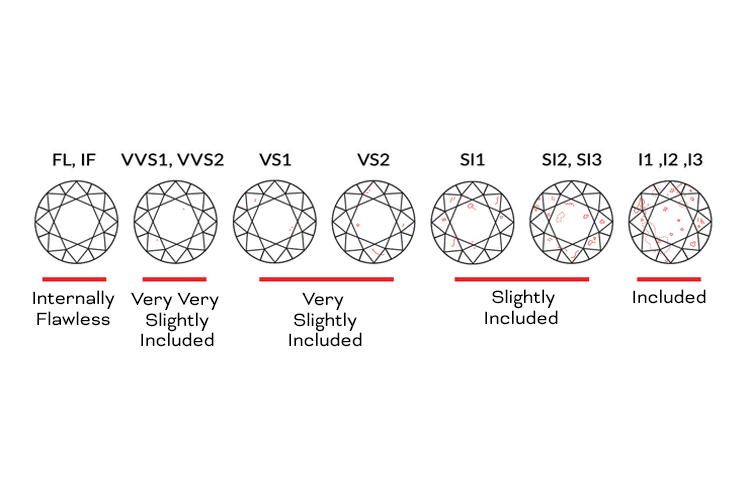
Tip: The location of inclusions makes a big difference: If you view a GH VVS1 and a J VS2 with your naked eye and they are both cut well — and the inclusions in the VS2 are not in the center of the stone or hidden under the setting — you will not be able to tell the difference and you will still be getting a nice white stone with a lot of life that will be easier on your budget (you save money if you buy the second diamond because J is inferior to GH and VS2 is inferior to VS1).
Visual examples: Below are price ranges for the two different diamond (with different color and clarity grades) that might look the same to the naked eye that Shaddaie has provided for modern cut diamonds:
Example 1: J Color VS2 Clarity
We list the ballpark prices for a diamond with these specs at three different sizes in the caption.
“This is a nice and healthy diamond to the naked eye and one that I would recommend if it looks white and any inclusions are in a place where the setting — prongs or bezel — would hide them,” says Shaddaie. (Photo by Blue Nile)
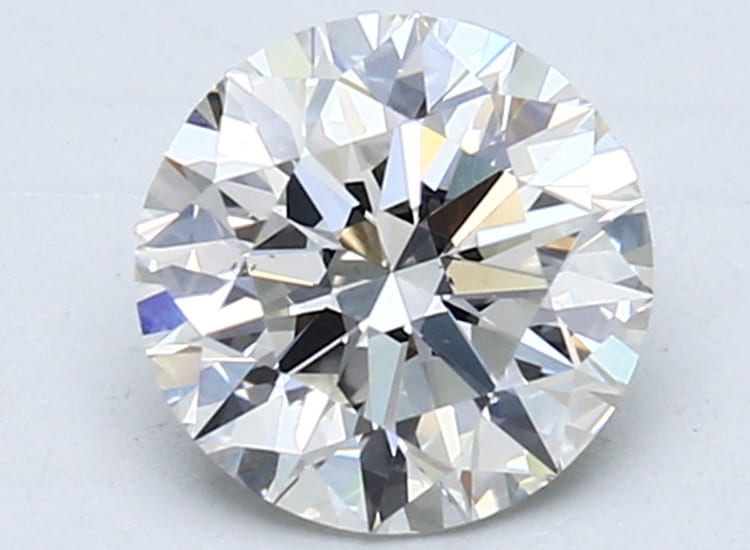
2-Carat: $17,000
3-Carat: $37,500
Example 2: GH Color VS1 Clarity
We list the ballpark prices for a diamond with these specs at three different sizes in the caption.
“This is [also] an excellent diamond to under 10x magnification and to the naked eye,” says Shaddaie. (Photo by Blue Nile)
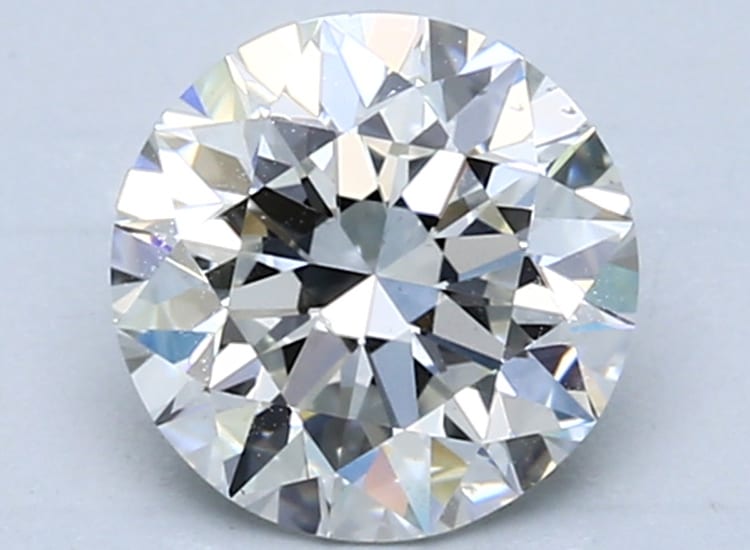
2-Carat $32,000
3-Carat $79,500
Tip: “For anyone considering an antique ring, or an upcycled old-European cut diamond: You can go to K color and it will still look white and full of life if all the other aspects are in place,” Shaddaie explains.
See also our guide to clarity
Certification & GIA Grading Reports
To ensure you are getting what you pay for (and to confirm that you’re not just looking at a fancy piece of glass), you will want to get the stats on the diamond from a reputable lab. Modern diamonds certified by The Gemological Institute of America (GIA) and American Gem Society (AGS) are most trustworthy. Below is what a GIA report looks like. It contains details that include the stone’s measurements and the 4C grades, plus details that will make your eyes glaze over.
See our guide on how to make sense of a GIA report.
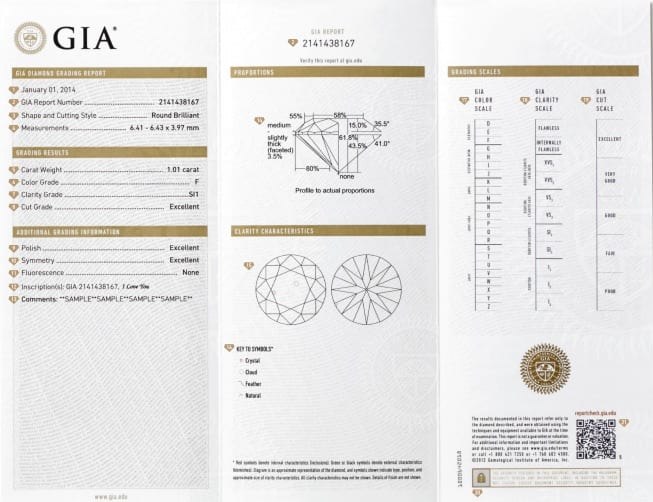
You should also always know where your diamonds come from — following them from mine to market and making sure they are conflict free. The shop Brilliant Earth has an illuminating explanation of what the “conflicts” are:
“Jewelers that offer ‘conflict free’ diamonds are limiting themselves to the Kimberley Process’ definition, which narrowly defines conflict diamonds as diamonds that finance rebel movements against recognized governments. What this definition leaves out is large numbers of diamonds that are tainted by violence, human rights abuses, poverty, environmental degradation, and other issues. We go beyond the usual standard to offer diamonds that have been carefully selected for their ethical and environmentally responsible origins. Learn more about the issues.”
“Although obtaining a certified report is a must,” says Shaddaie, “you should know that it doesn’t tell you everything. It should act as a guide but some diamonds look better on paper than they do in person, even if the paper has all the information. Therefore, you should also definitely see the diamond in person.”
What’s more, “A GIA report will evaluate the diamond as being, say HI color and VS2, but it won’t let you know where the slight inclusion is — if it’s in the middle of the stone or the side where it can be hidden,” says Shaddaie. “The cut might also look very good on paper, but does it have the proportions to give it the life it’s supposed to? All this can be solved with the report and making sure you examine the diamond under 10x magnification and with the naked eye to see whether this is the one for you.”
Diamond Shapes: Round vs. Everything Else
Go to Whiteflash or James Allen to see what kinds of ring designs work best with that shape (and others). Their selection spans from vintage to modern — and across all budgets.
Some people refer to shapes as cuts, but that’s confusing. You should know that some shapes, like round, pear, heart, and oval, are just what they sound like. Others, like asscher, marquise, radiant, cushion, and princess, may be words that are brand new to your ears. Below, we display the most common shapes:
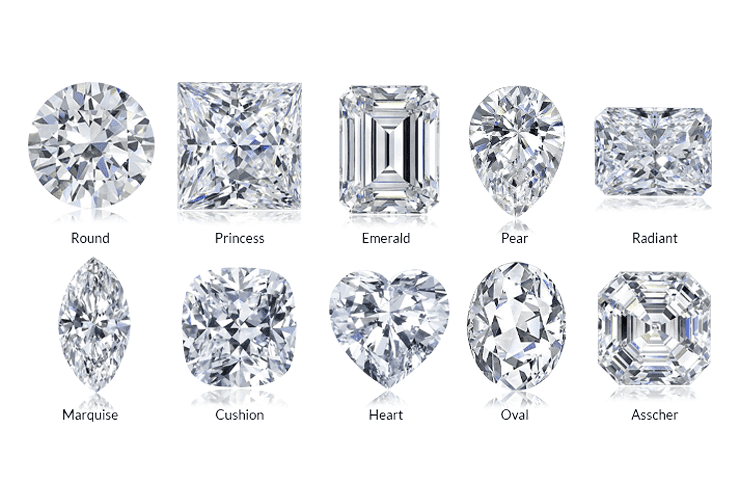
Round Brilliant
This is the classic and most popular shape — more than 50 percent of diamond rings have this shape — since it works with almost every setting. It will always be the most timeless shape, making it perfect for any woman with traditional tastes. See our complete guide to round cut diamonds. (Photo by Greenwich St Jewelers)
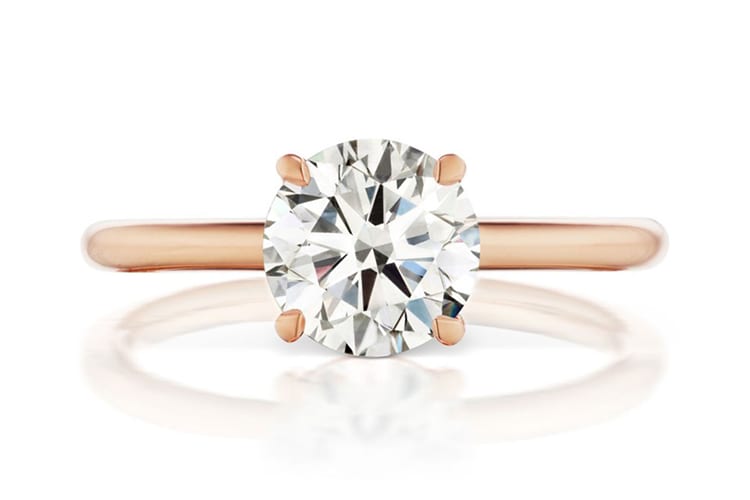
Emerald
Sophisticated and popular with women who prefer elegance to bling, this style is streamlined and low key and was used in Art Deco styles from the 1920s onward in geometric shapes. Note that an emerald cut diamond is not green; that would be a different gem, an emerald. See our complete guide to emerald cut diamonds. (Photo by Estate Diamond Jewelry)
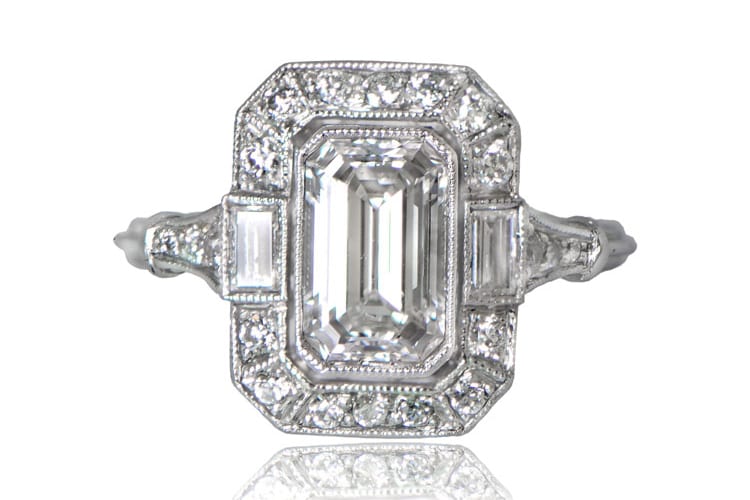
Cushion
One of the most prominent cuts in the 19th century, this shape today is available in either upcycled versions — which were taken out of the original settings, allowing for sustainability — or newly cut to look like the originals. Cushion cuts have sparkle, but not as much as other diamonds, and it looks good in both antique and modern settings. See our complete guide to cushion cut diamonds. (Photo by Estate Diamond Jewelry)
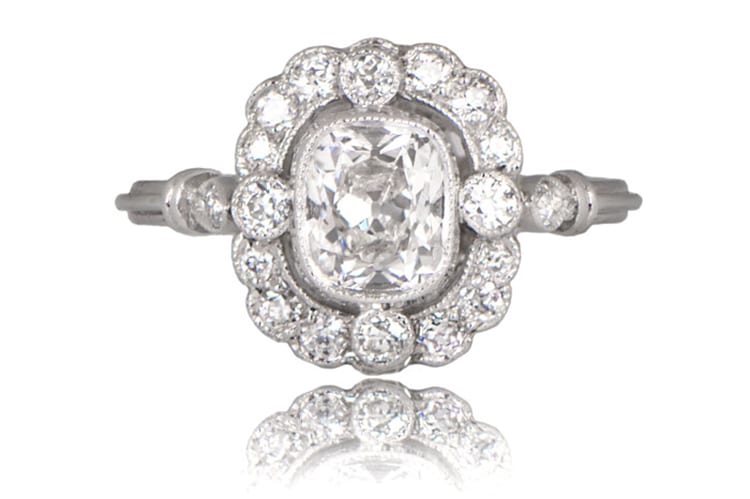
Pear
Pears go in and out of style. They have been trending for several seasons now (2019, 2020, etc.) and is a stone that is appreciated by a new generation of women. Women can wear the pear diamond ring facing up or down or even left and right. See our complete guide to pear cut diamonds. (Photo by Greenwich St Jewelers)
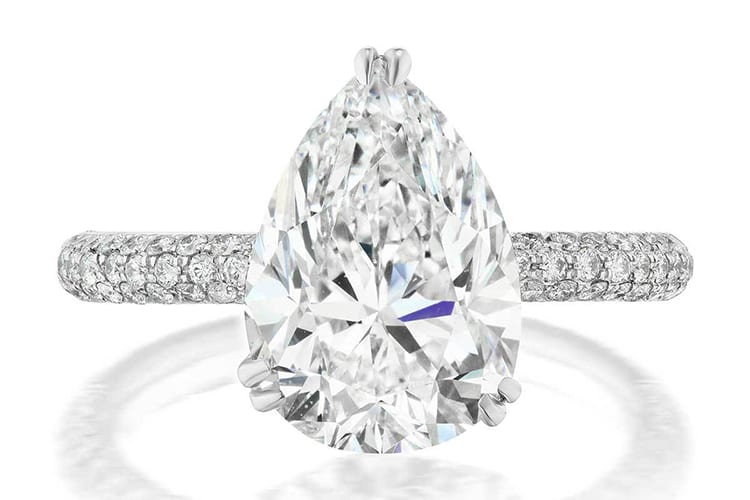
Marquise
Originally, in the early to mid-twentieth century, it was designed to be worn from north to south. The newest way it’s being set is from east to west for women who like a diamond that covers the width of their finger. See our complete guide to marquise cut diamonds. (Photo by Sasha Primak)
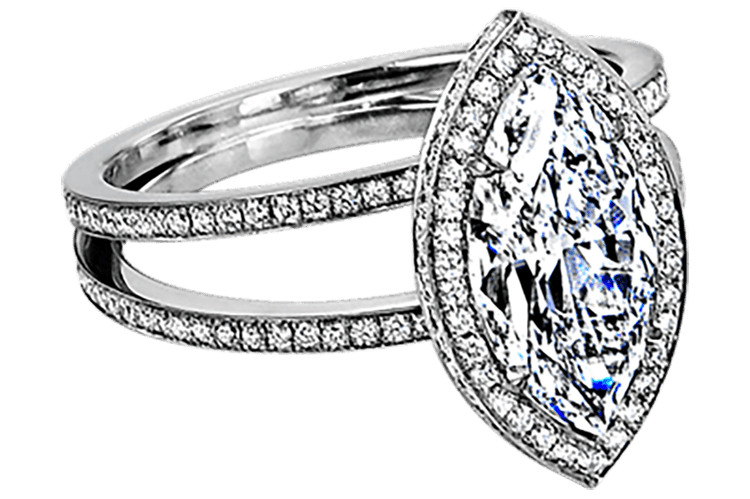
Princess
Another shape of diamond that has become popular again, the princess looks best in smaller sizes, set into rings styles and/or settings with intricate details. See our complete guide to princess cut diamonds. (Photo by Sasha Primak)
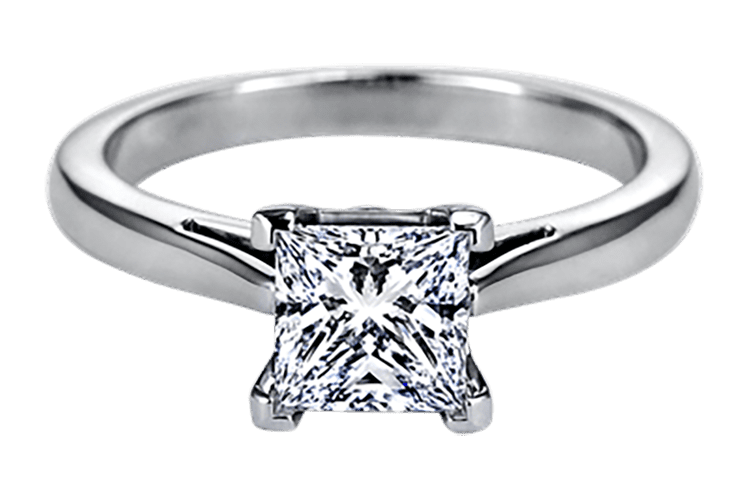
Oval
These can range from traditional to trendsetting and can be set from north to south or east to west. They are being used more and more by independently minded women to make the finger look longer and more slender. See our complete guide to oval cut diamonds. (Photo by Estate Diamond Jewelry)
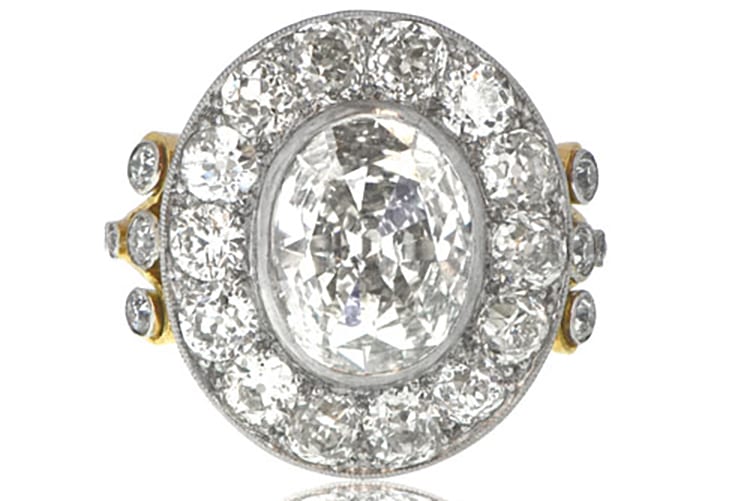
Asscher
This is a beautiful shape but you’ll need to move up a notch in clarity when you’re working with Asscher cut diamonds. Like the emerald cut (but with a bit more sparkle), it has a flat top and you’ll be able to see more inclusions. See our complete guide to Asscher cut diamonds. (Photo by Estate Diamond Jewelry)
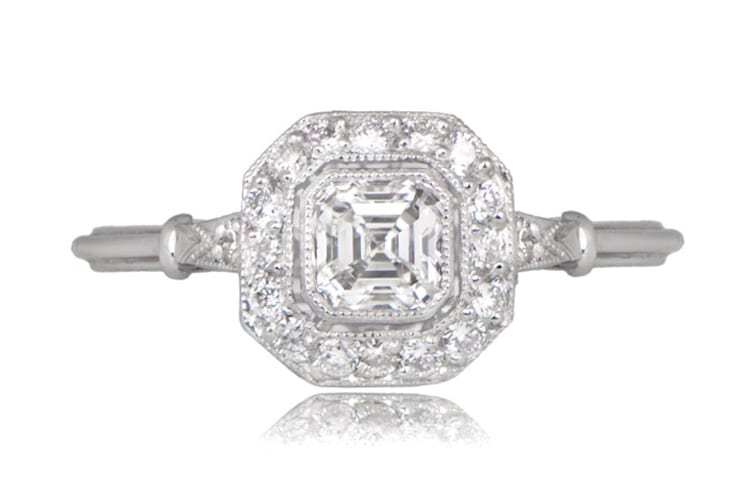
Radiant
Rectangular or squarish in shape, radiant cut diamonds are imbued with the brilliance of a round diamond, yet take on the geometry and sophistication of an emerald or Asscher cut. See our complete guide to radiant cut diamonds. (Photo by Blue Nile)
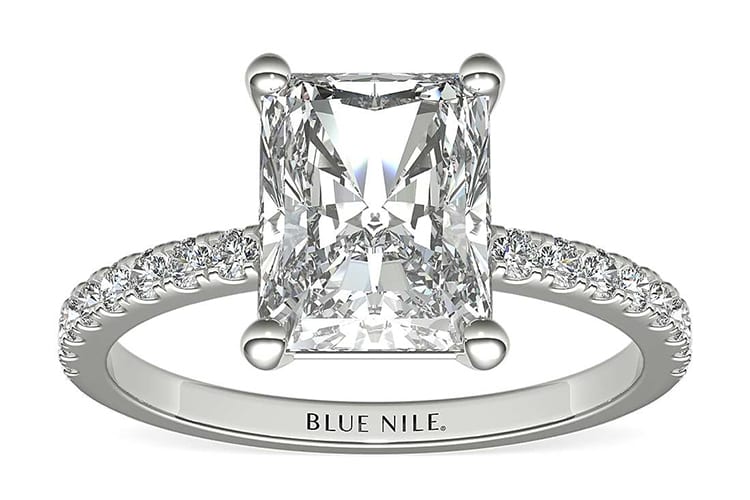
Fire, Scintillation & More Confusing Criteria
In our guide to brilliance, fire and scintillation, writer Jerilynn Kraus compares these characteristics to superpowers.
Superpower No. 1 is diamond brilliance.
Think: White light.
Also called brightness, it’s the effect of all the internal and external white light reflected from a diamond’s facets back to your eyes. Imagine Emma Frost of X-Men fame in her all-white outfits, or better yet, in living-diamond form. (Photo by Ritani)
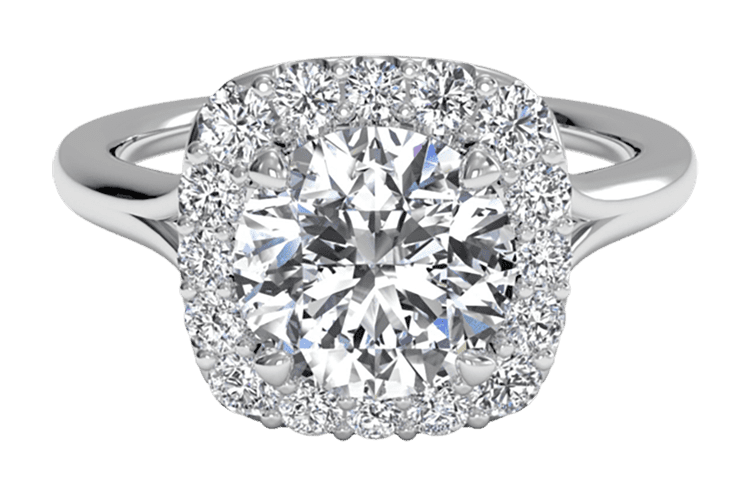
Superpower No. 2: diamond fire.
Think: Fireworks.
Fire features bursts of colors much like the “fireworks” that teen superhero Jubilee generates from her fingers (but without the temporary blindness or fatal detonation). You can see yellow, blue, and violet colors throughout the diamond below. (Photo by Imreco Import, Inc.)
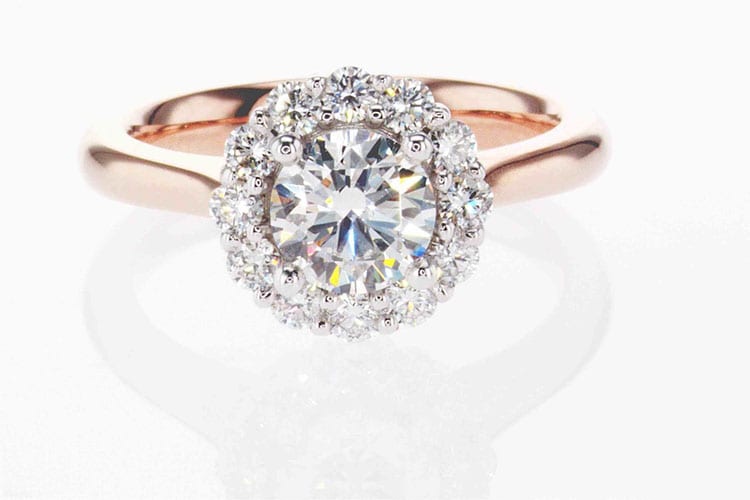
The image below shows the effect of light dispersion in a diamond. White light enters a diamond, splits into the seven colors of the spectrum, and is returned to your eyes as colorful twinkles called “fire.” (Photo by the Gemological Institute of America)
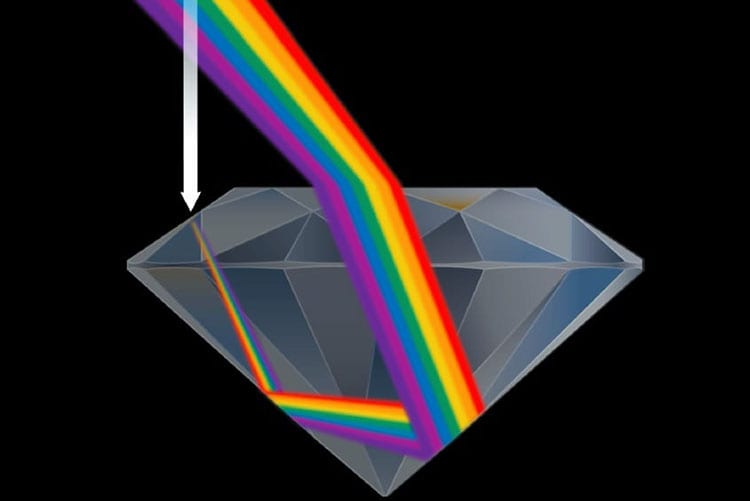
Superpower No. 3 is diamond scintillation
Think: Flashes of light.
Scintillation is sparkle, flashes of light, caused by reflections within the diamond as it moves in the light. Scintillation also includes brilliance and fire, resulting in a mix of light in motion. (Photo by DiamondGalaxy / Shutterstock)
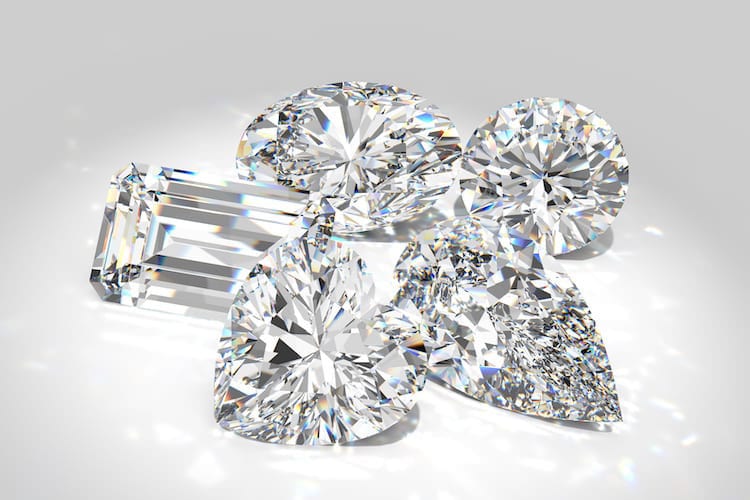
The two other key words to know are symmetry and polish (alas, we have no superpowers to compare them to). They mean what they sound like: how well proportioned is the stone and are the surfaces smooth?
Symmetry is defined as the exactness of a finished diamond’s shape and the arrangement and placement of its facets. A symmetrical diamond has an even display of brightness, fire, and scintillation.
Polish refers to the overall quality and condition of a diamond’s facet surfaces. If there’s any roughness or exterior blemishes on the facets, these can act like speed bumps, interrupting the light and bouncing it in all the wrong directions.
Ring Settings: What’s Holding the Stone?
Here’s how James Allen displays the setting options on its site:

Solitaire/Prong Setting
In short: A solitaire is a single-stone engagement ring of any shape (round, princess, pear, etc.) that can be set in many different types of settings. The most classic setting is a prong setting.
The details: Prongs usually involve four or six small claw-like metal structures that hold the diamond. Prongs use less metal than any other setting, thus allowing more light to pass through to display its brilliance. The most popular prong setting for solitaire diamonds is the one Tiffany & Co. debuted in 1886 with six prongs. For more, read our guide to prong settings. Solitaires can also be set in bezel settings (see our explanation below).
Examples: Greenwich St Ceremony Hudson solitaire engagement ring setting. (Photo by Greenwich St Jewelers)
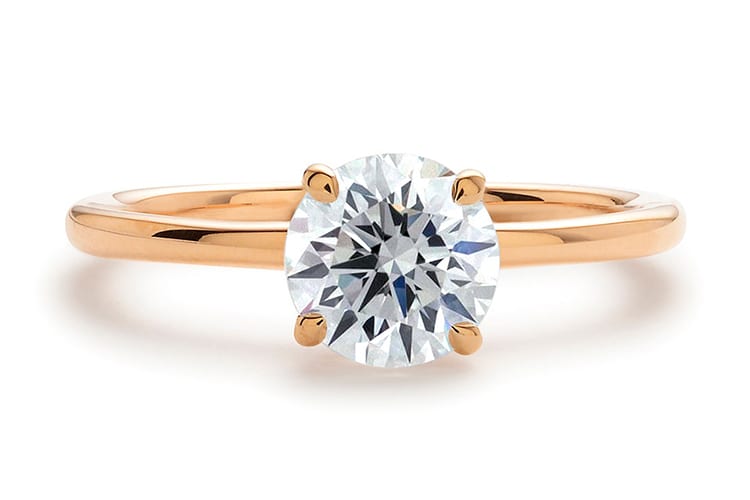
Below, left: Four-prong petite comfort ring in white gold. Below, right: Six-prong petite comfort ring in white gold. (Both photos by Brilliant Earth).
Below, left: RoyalT four-prong ring in 18K yellow gold. Photo by Tacori. Below, right: Greenwich St. Collection Baxter four-prong white gold ring. Photo by Greenwich St Jewelers.
Pros:
- Less metal, allowing more light.
- Four prongs secure the diamond but six prongs will secure it even more.
- Accents almost every diamond cut/shape and size.
- Prongs are often easy to maintain and wear as long as they are set low (as opposed to high where they snag on clothes).
Cons
- High-set prongs can snag on clothing, thus loosening the prongs.
- Generally, prongs tend to loosen with age so it’s important to get them checked every couple of years. You can put the ring up to your ear and shake gently, and if you hear the diamond moving around at all, it’s time for a prong check.
Bezel Setting
In short :A bezel setting surrounds the diamond with a metal frame that holds the diamond securely in place.
The details: Solitaires (remember, they are a single stone) can be set in bezels, too, and often look more modern than prongs. The design keeps them at a low profile, sitting closer to the finger than prong-set rings. For more info, read our guide to bezel settings.
Examples: Greenwich St Sholdt bezel solitaire engagement ring setting. (Photo by Greenwich St Jewelers)
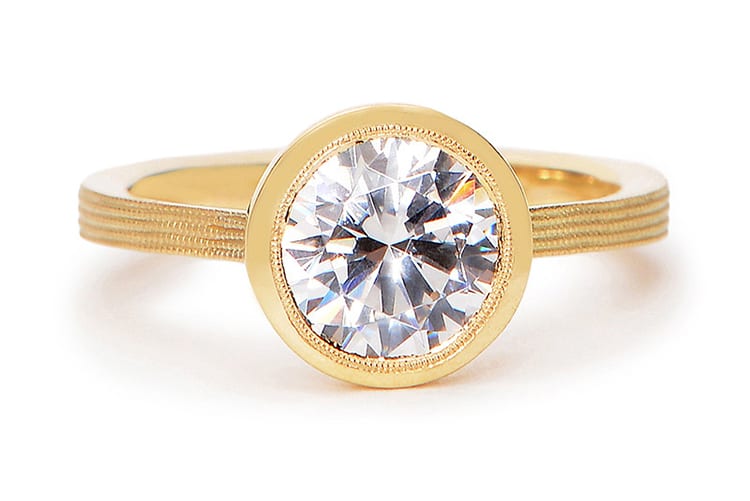
Below, left: Ashoka cut diamond ring bezel set with pave diamond band set in platinum. Photo by Kwiat. Below, center: Round brilliant diamond ring bezel set in platinum. Photo by Kwiat. Below, right: Noam Carver bezel diamond engagement ring setting with milgrain. Photo by Greenwich St Jewelers.
Pros
- The most secure setting for a diamond.
- Can create an ultra-sleek modern style.
- With milgrain details, it can give an antique/vintage feel.
- Will not snag on clothing.
- A great setting for an active lifestyle or a career in which your bride-to-be works with her hands.
Cons
- Does not allow as much light, thus lessening some of the brilliance of a diamond.
- Hides a bit more of the stone than some of the other settings.
- It is harder to set perfectly around diamonds that aren’t round, such as pear, marquise, emerald, and asscher cuts, so make sure the jeweler’s setter is an expert in bezel set rings.
Halo/Cluster Setting
In short: Halos feature a border of smaller diamonds that encircle the central diamond, making the main diamond appear larger and more sparkly than it truly is.
The details: Great if you are on a budget and need to choose a smaller diamond and surround it with a halo setting. Halos can be designed to accommodate any diamond shape — for example, round for round diamonds and square for princess cut. There are also different styles of halos. Clusters date back to the 19th century and have been popular ever since. This style creates more of a floral shape with the outer rim of diamonds. For more info, see our guide to halo settings.
Examples: Greenwich St Sylvie collection diamond halo ring setting. (Photo by Greenwich St Jewelers)
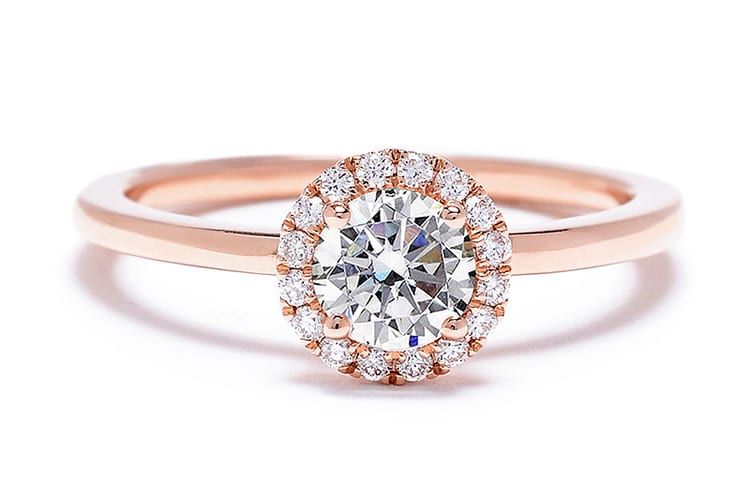
Below, left: Classic halo ring with diamond shank in platinum. Below, right: Cushion cut halo ring in platinum. Both photos by Blue Nile.
Below, left: Norfork cluster engagement ring with a row of old mine cut diamonds, hand-crafted in platinum. Below, right: Yorkshire cluster diamond engagement ring that centers an old European cut diamond, hand-crafted in platinum and yellow gold. (Both photos by Estate Diamond Jewelry)
Pros:
- Can make the stone look larger look for less.
- The ring appears to display more sparkle.
- Offers more security around the center stone.
- Different types of styles are available in this setting, forming a floral look and/or complementing other cuts of diamonds.
Cons
- Although it helps secure the center stone, the halo’s smaller stones are in danger of becoming loose or falling out. Rings based on antique styles with bezel-set halos are less likely to come loose.
Three-Stone Settings
In short: Just like it sounds, there are three stones, but you can vary the number of diamonds — one or two — based on budget and style preference.
The details: A style that was first popular in the late 18th and early 19th centuries, the three-stone ring was originally set down into the metal and designed with decorative elements such as filigree (open scroll work). The ring is recognized as symbolic of a couple’s “journey,” with the three stones representing their past, present, and future together. The three stones can be all the same size or the center stone can be larger and the two side stones the same size. For more info, see our guide to three-stone settings.
Examples: Three-stone ring with pavé-set diamond detailing all set in enduring platinum. (Photo by Blue Nile).

Three-stone bezel-set diamond ring set in platinum and exhibiting antique-cut diamonds. (Photo by Estate Diamond Jewelry).
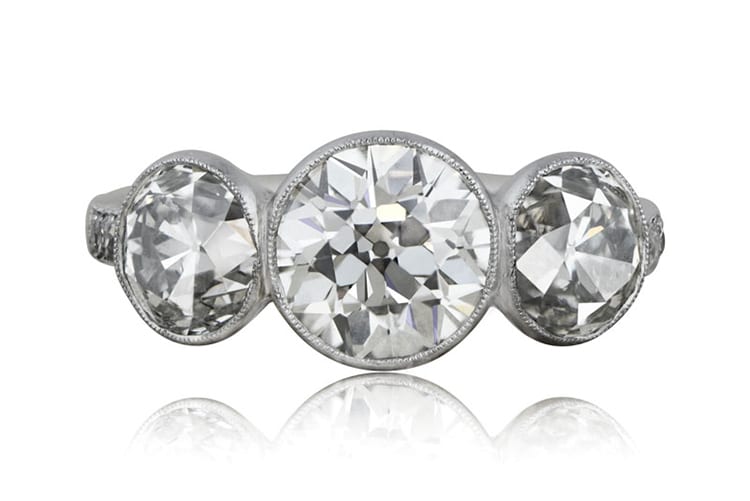
Pros:
- Allows for multiple larger stones.
- Features a charming and romantic feeling with two smaller side stones and a larger center stone.
- This style provides more coverage horizontally across their finger, which appeals to a wide demographic of women.
- Bezels can be highly polished or can feature milgrain detail for an antique or vintage vibe.
Cons:
- Higher maintenance than a single stone ring.
- If prong-set, it will need to be checked more often.
- If bezel-set, it will need to be cleaned more often.
- The diamonds need to match to bring out the beauty of the entire ring and not look like a way to fake larger size.
Flush/Gypsy Settings
In short: Originally called a gypsy setting in the late 19th and early 20th century, they were often set with one or three stones. A jeweler drills a hole into the band, then works the metal around the diamond to hold it in place. The diamond then sits securely in the band of the ring.
The details: These are available in one- or three-stone styles for engagement rings. Dandy men would wear them on their pinkies. Then in the mid-20th century through the 1970s, they became popular again with men. For more, see our guide to gypsy settings.
Example: Emerald-cut diamond ring with two triangle diamond sides in 18K yellow gold. (Photo by Brent Neale)
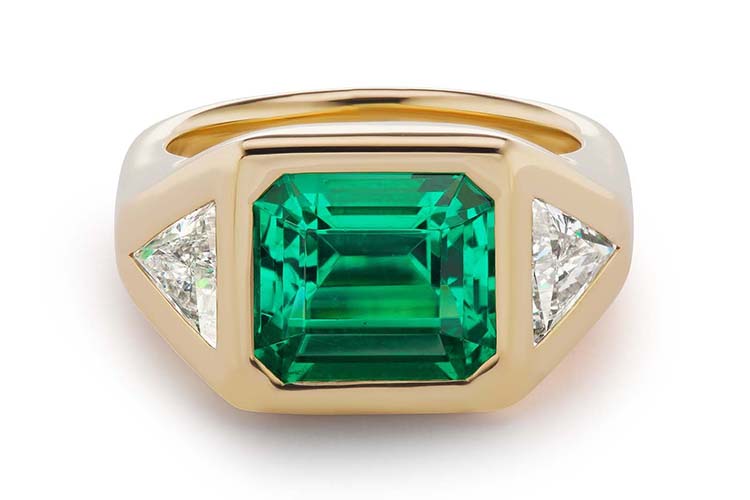
Pros
- When set correctly, this offers one of the two most secure settings — the other being the bezel-set ring.
- Depending on the size of the diamond, this setting can offer a bold statement look or a more subdued streamlined appearance.
- It’s a versatile choice for people with active lifestyles and those who work with their hands.
- Gypsy and signet style rings have become fashionable in 2020.
Cons
- This style is the one that shows the least amount of light passing through the stone.
Tension Settings
In short: Named after how the metal holds the gem — with tension.
The details: A jeweler calibrates the exact dimensions of the diamonds so that he can cut small grooves in the exact spots where the diamonds will be held. Then, he pushes the metal down to create the pressure to secure it, making the diamond appear to be suspended in place.
Examples: Danhov Voltaggio knife edge princess-cut engagement ring. (Photo by Danhov).
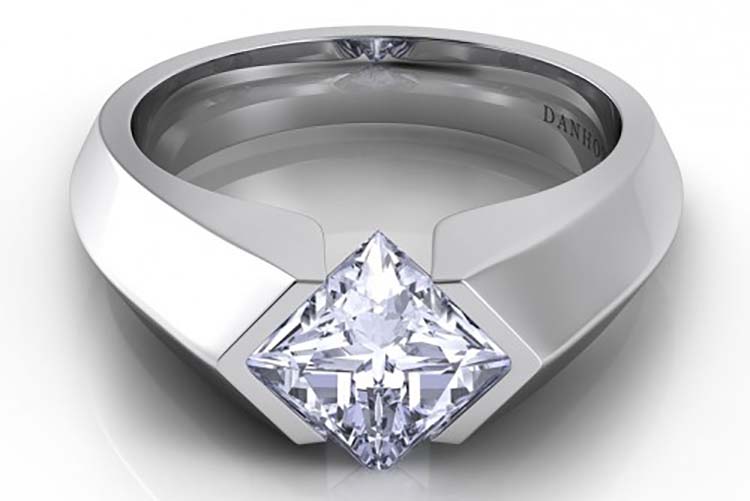
Kretchmer 18 karat softened hard omega hard tension set ring. (Photo by TQ Diamonds).
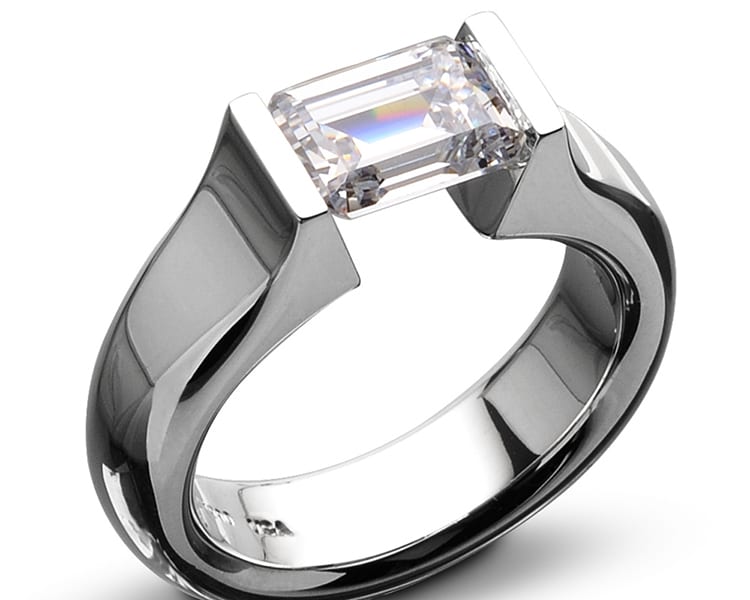
Pros
- Offers a sleek, ultra-modern look.
- Like a prong-set ring, there is a minimal amount of metal around the diamond, thus enhancing its brilliance.
Cons
- Even though the metal might be secure, the look of the tension setting causes anxiety since the diamond “appears” as if it could fall out.
- When and if it needs to be resized, it will often be more expensive. Many jewelers will want to remove the diamond and reset it so the process of sizing doesn’t loosen the force or pressure holding it together.
- Tough to clean in some cases.
Cathedral Settings
In short: A cathedral is more of a style of setting. The diamond itself could be held by prongs or a tension setting that is built up by what looks like cathedral arches, which you can see on the underside of the diamond.
The details: It’s a graceful style that features an elegant detail for the bride-to-be who wants something classic, timeless, and yet more unusual than a basic prong setting.
Examples: Erica Winters Grace Cathedral 1.25 carat engagement ring. (Photo by Greenwich St Jewelers).
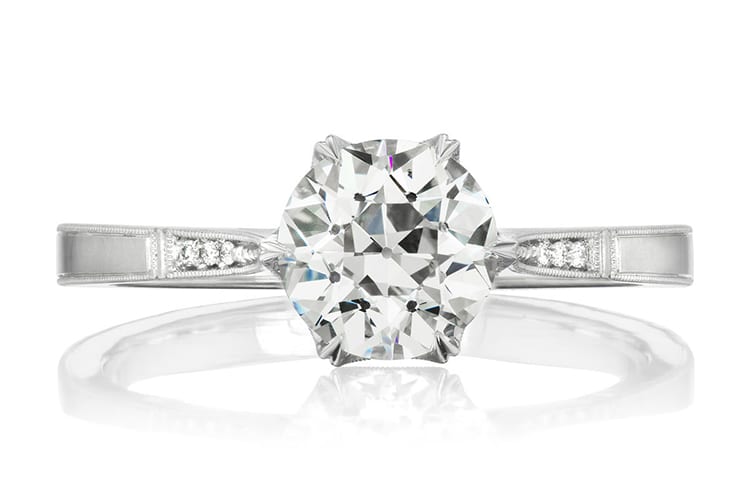
Petite Cathedral pavé in platinum. (Photo by Blue Nile)

Pros
- The added height of the arches seems to give the diamond a larger look.
- It creates a look with more personality and elegance than the basic prong setting and accentuates and highlights the center stone.
- Offers a secure setting for the diamond.
Cons
- There are lots of openings and crevices, which makes it hard to clean.
- It sits very high, which means it can snag on clothes.
- If you are looking for a ring that allows the diamond to stand out more than another component of the ring, a cathedral setting might have too much going on.
Split Shank
In short: Instead of one continuous band, it splits into two thinner bands that wind up in the same place at the back of the ring.
Example: Cushion cut diamond ring with split diamond band and diamond frame set in platinum. (Photo by Kwiat).
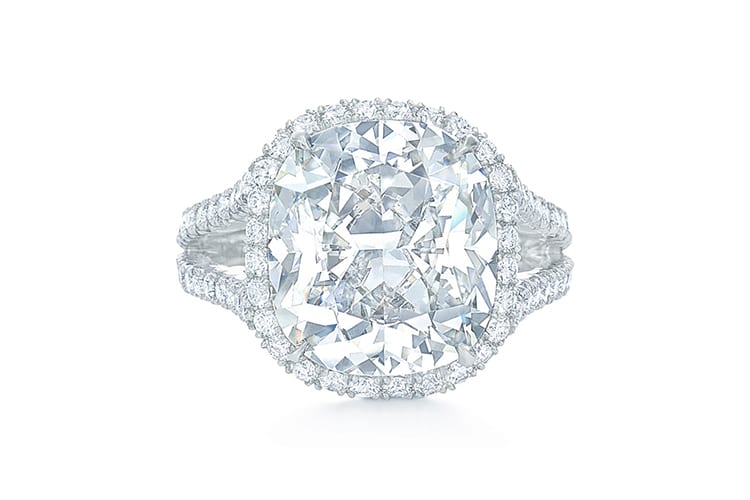
Pros:
- Eye-catching symmetry.
- Works great with halo settings.
- Has space on the sides for more stones (pavé).
Cons:
- Can be hard to clean.
- Can be cumbersome for people who work with their hands.
Pavé
In short: Small diamonds follow the curve around the finger and look like they are pavéd (attached) around the ring.
The details: What’s really happening is that tiny beads (often as small as .01-.02 carats) are holding the diamonds on the shank in place. If your lady likes a lot more glamour and bling, this might be the style for her.
Examples: There are three subspecies displayed below.
Micro Pavé: As you might have gathered, the stones lining the band in a micro pavé ring are even smaller than usual — they can be as tiny as 0.01ct per stone. Thus, there may be hundreds of these mini diamonds, which creates major bling. Below: Petite micro pavé diamond engagement ring. (Photo by Blue Nile).
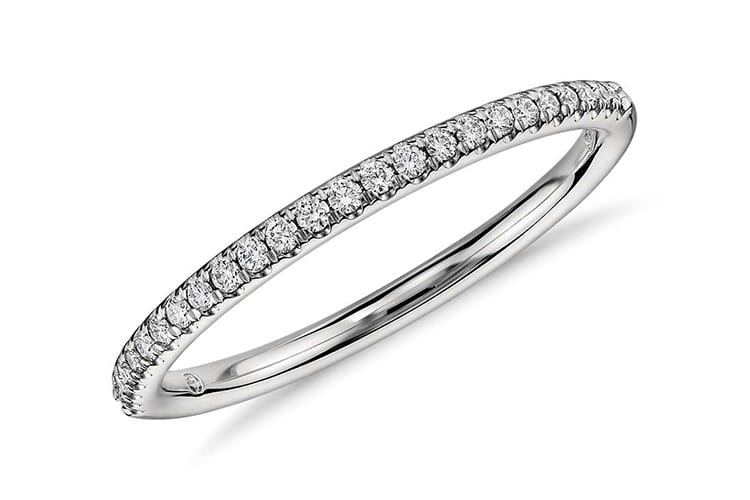
French Pavé: This is a technique in which small v-shaped structures are under the diamonds, holding the pavé stones and letting more light pass through. Below: French pavé diamond engagement ring. (Photo by Blue Nile).

Petite Pavé: Small pavé stones mixed with small prongs. Below: Petite pavé diamond engagement ring. (Photo by Blue Nile).

Pros:
- Small stones line the band and add sparkle.
- It focuses attention on the center stone.
- This type of ring can can look modern or vintage.
Cons:
- There’s potential to lose some stones.
- Resizing can be tricky if stones line the entire band.
Channel-Set Shank
In short: This style features two strips of metal that curve around the finger and hold the diamonds in place with each strip. They have more metal than pavé-set bands, therefore they don’t add as much bling, but they do add more sparkle to the ring.
The details: Pavé- and channel-set shanks work best with the bezel, prong, and halo styles. There are also half pavé and half channel shanks that encircle only the part of the finger that can be seen. For more info, read our guide to channel-settings.
Example: Diamond engagement ring showcasing twelve princess-cut diamonds channel-set in 14k white gold and accenting a center diamond. (Photo by Blue Nile).
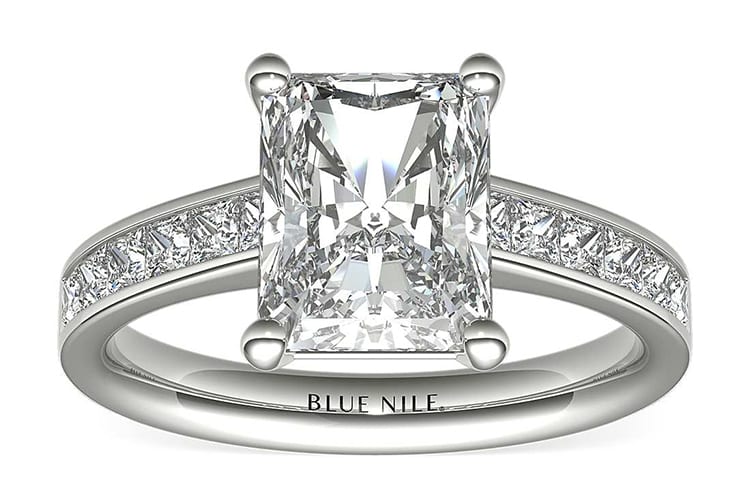
Pros:
- No prongs.
- No snagging.
- Strong grip on stones.
Cons:
- Sometimes tough to clean and resize.
Antique & Vintage
In short: “Antique” refers to jewelry that is over 100 years old. “Vintage,” on the other hand, applies to jewelry that is anywhere from 20 to 100 years old, but more often in engagement rings, it refers to rings that are classified as Art Deco, Retro, or Mid-20th Century.
The details: Around 15 to 20 years ago, women started recognizing that bigger isn’t always better when it comes to diamonds, and that a ring that represents individuality is more important than keeping up with peers. During this time, savvy designers who were contemporaries of the brides-to-be, started creating alternative engagement rings for women like themselves who wanted something different. This led to a desire for the ring to be as unique as the couple’s relationship, which has in turn driven the popularity of antique/vintage rings, not only among seasoned collectors but with women looking for “the one” — a non-generic ring with inherent romance, an intriguing past and an enduring future.
See our guide to antique and vintage rings. We’ve also identified some of the best antique/vintage ring sellers in a comparative review.
Example: Roslyn Collection Platinum Octagonal Bezel Pave-Set Split Shank Trellis Engagement Mounting. (Photo by Tiny Jewelry Box).
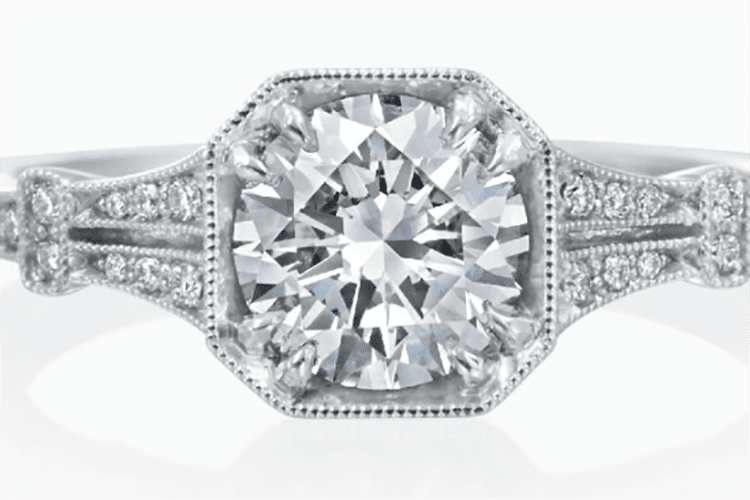
Metals: Gold vs Platinum
Forget all the hype about new metals: Palladium! Tungsten! Serinium! The vast majority of engagement rings are made of either platinum or gold, and this includes modern and classic styles. The distinctions within gold include issues of purity (14k vs 18k) and color (white, yellow or rose). Here’s how Blue Nile displays the metal options on its site.
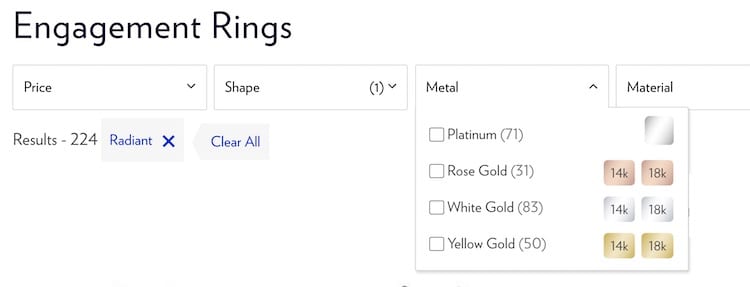
Platinum
Platinum never dulls or tarnishes, and its awesome strength and durability make it perfect for complicated engagement ring designs. It’s also the rarest of the precious metals — 30 times rarer than gold — and thus, comparatively pricey. Platinum generally has a white color, which is great for making the diamond look bigger and spotlighting the details of the setting.
Example: Roslyn Collection Platinum Three Leaf Engagement Ring Mounting. (Photo by Tiny Jewel Box).
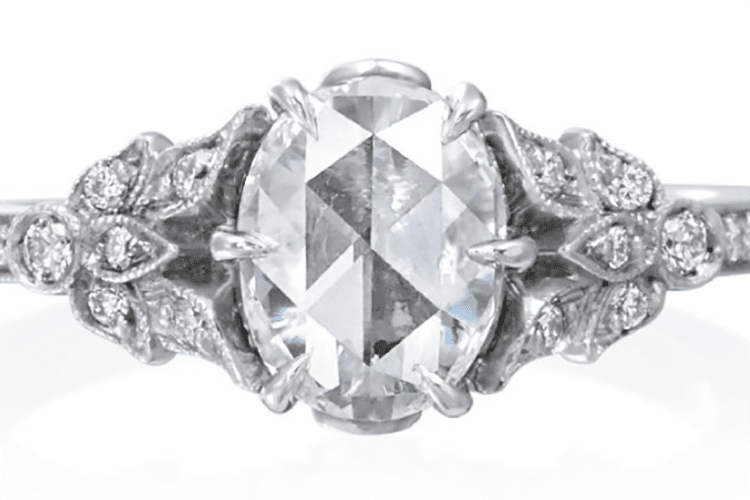
Gold
Gold is measured in karats, but it’s not a measure of weight or size. Karats in this case measure the purity of the gold, which affects ring color and strength. Pure gold (24K) is so soft that it has to be mixed with harder metals to make it practical for jewelry. The two most common blends are 14K (58.3% pure) and 18K (75% pure). The latter has a richer look, but it may not be noticeable enough to warrant spending more.
Gold also comes in different shades: Yellow gold is what’s inside Fort Knox. When it’s mixed with white metals like rhodium, it’s called white gold and looks similar to platinum. When mixed with copper, it becomes rose gold.
Which is best? That depends on your budget and style. As with platinum, white gold makes a diamond appear larger, yellow gold will warm up a diamond with its reflection, while rose gold is more feminine and romantic.
18K Yellow Gold
Example: Roslyn Collection Yellow Gold Octagonal Halo and Trefoil Diamond Sides Engagement Mounting. (Photo by Tiny Jewel Box).
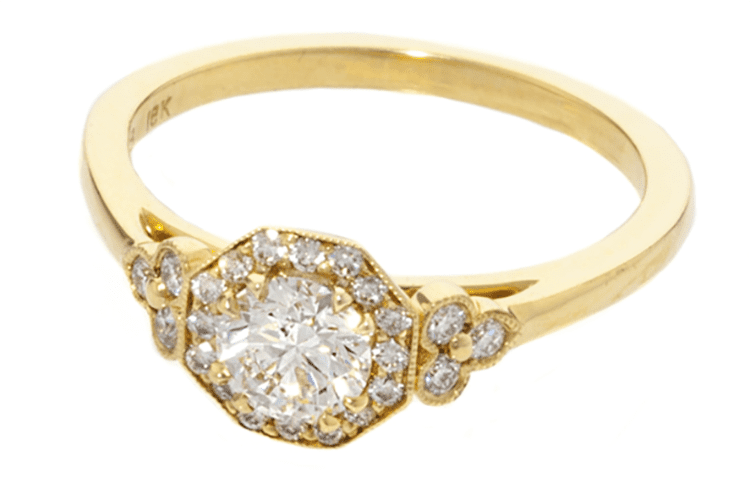
18K Rose Gold
Example: You could use any shape diamond in this Blue Nile 18K rose gold 3-stone setting with pear-shaped diamonds. (Photo by Blue Nile).
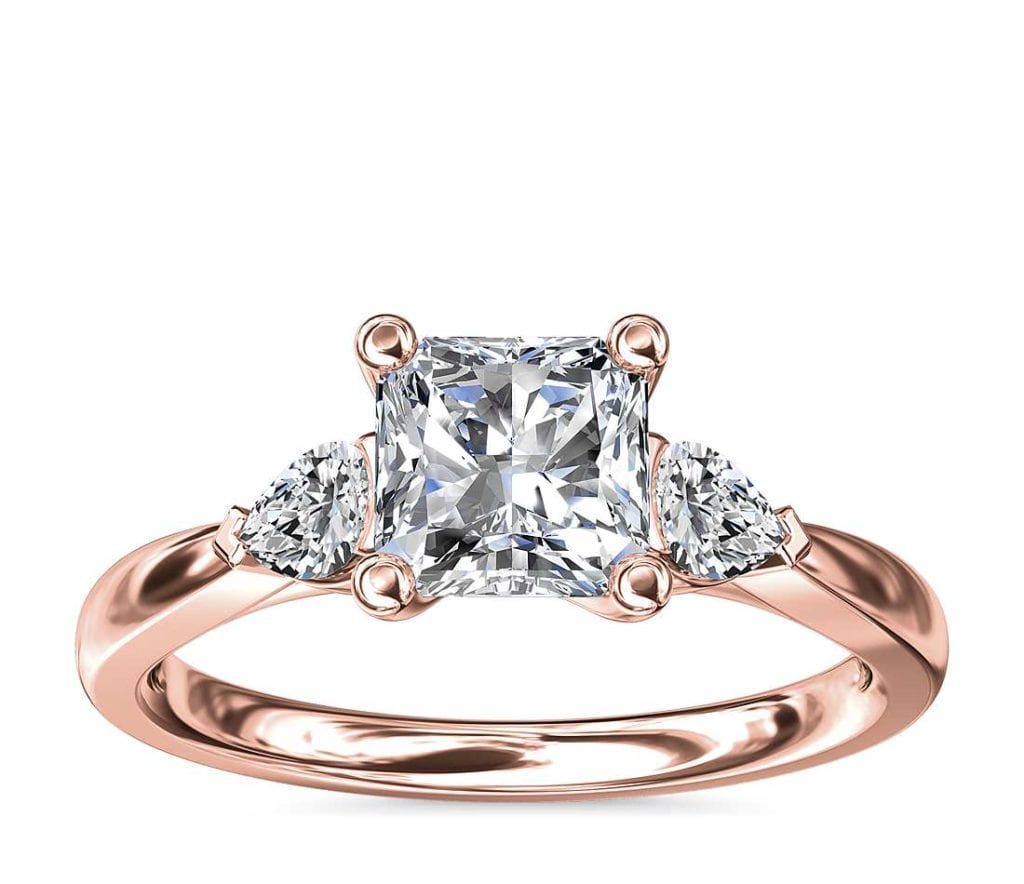
14K Yellow Gold
Example: Jennie Kwon melody baguette diamond engagement ring. (Photo by Greenwich St Jewelers).
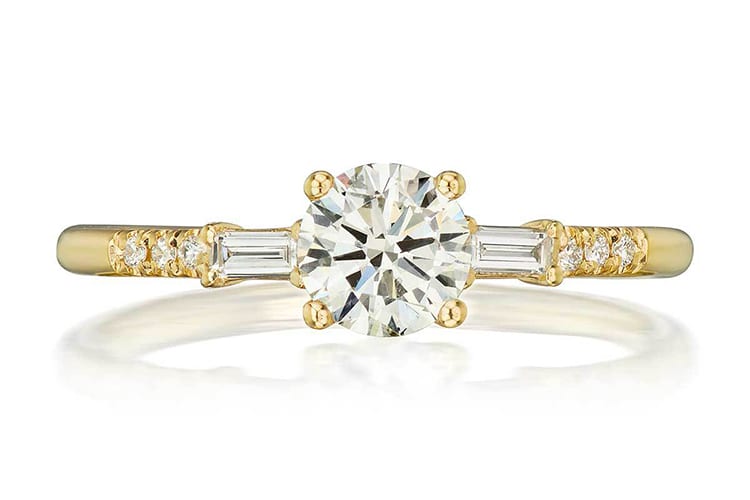
14K Rose Gold
Example:
Noam Carver floral & vine diamond engagement ring setting. (Photo by Greenwich St Jewelers).
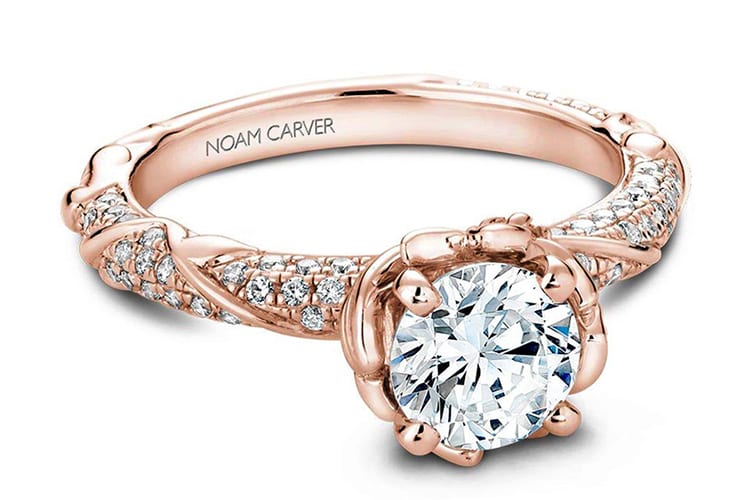
Ring Styles: Modern, Antique or Classic?
Your bride-to-be has a style. And you want to match her ring to her vibe. When searching online and/or talking to jewelers, you’ll need, at some point, to say, “she wants a traditional ring” or “no, she’s more of a modern type.” These styles supersede issues of diamond size, color and shape; metal specifications; and setting style.
Classic/Traditional
In short: You’ll see four- and six-prong set solitaires with brilliant-cut round diamonds, clean-lined shank or two thin baguettes on either side, often with pear-shaped solitaires.
Examples: Rose gold solitaire engagement ring mounting. (Photo by Tiny Jewel Box).
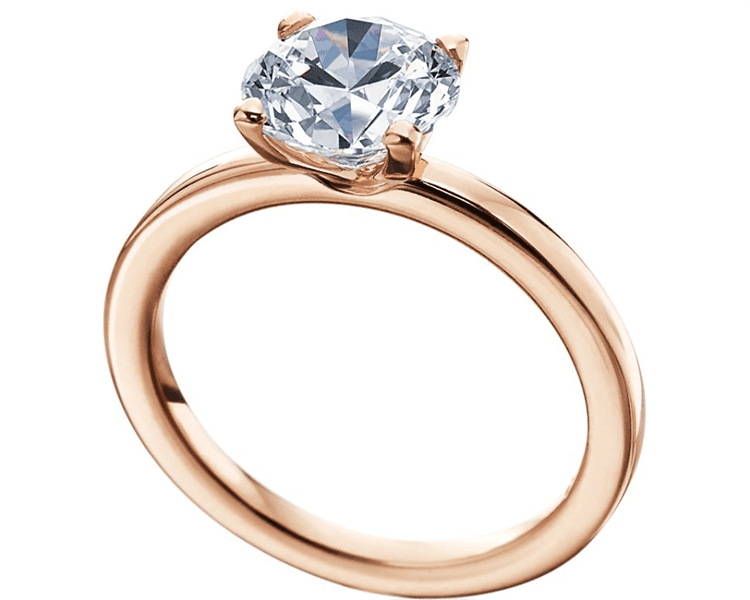
Platinum tapered baguette and princess engagement ring. (Photo by James Allen).
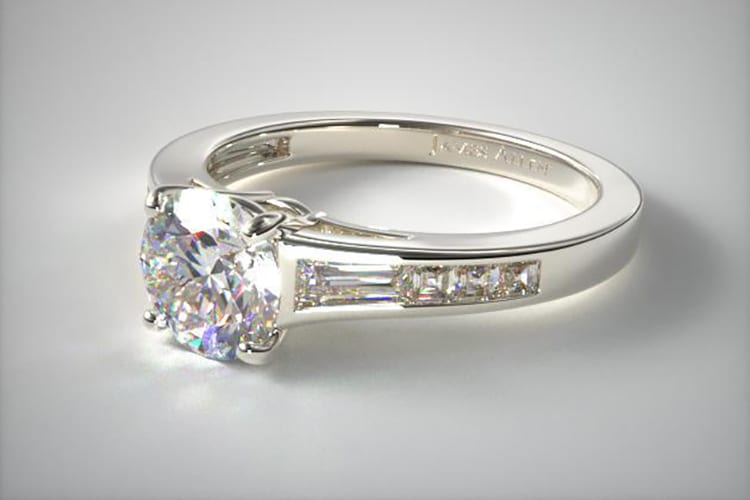
Antique/Vintage
In short: There are several types, including Victorian cluster rings with smaller diamonds surrounded by a larger diamond in old mine cuts; Edwardian style, intricately detailed platinum rings with piercing work, filigree and/or millegrain; and Art Deco, which features streamlined designs with a European cut diamond center stone in geometric shapes or with piercing work. All of these styles rest close to the hand instead of sitting up high.
Examples: Jolie Edwardian diamond cluster ring. (Photo by Ashley Zhang).
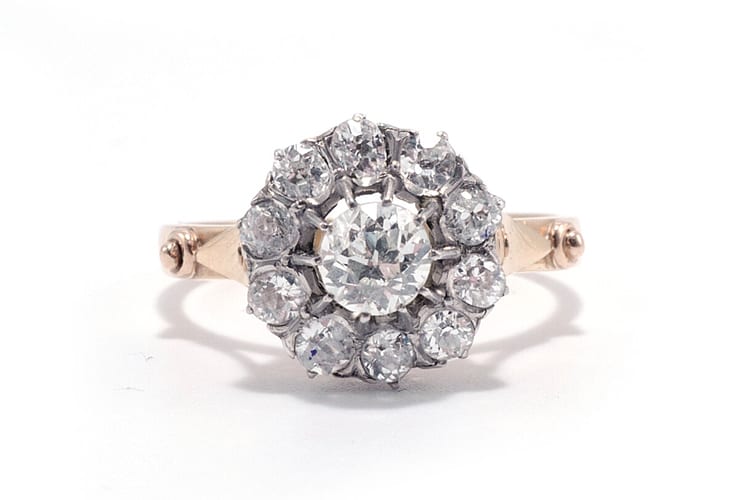
Bernex Ring, circa 1925. (Photo by Estate Diamond Jewelry).
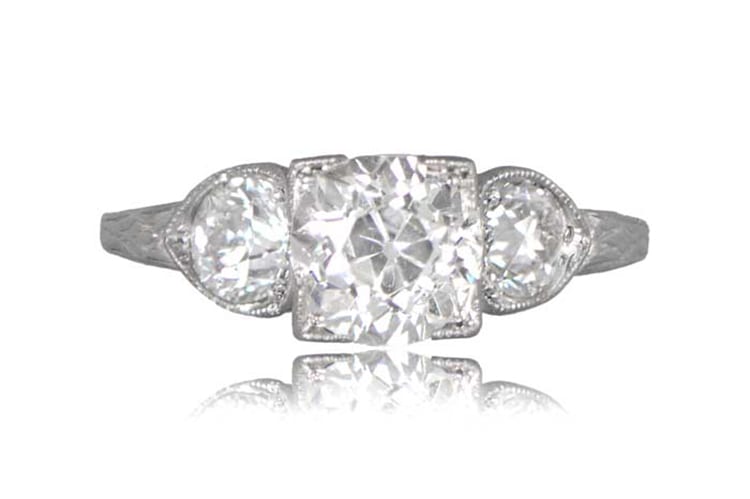
Modern/Cutting Edge
In short: Think of tension-set solitaires with round stones, gypsy-set cushion cut rings, bezel-set round and cushion cuts, and Asscher or Emerald cut rings.
Examples: Rose gold Florentine solitaire engagement ring. (Photo by Tiny Jewel Box).
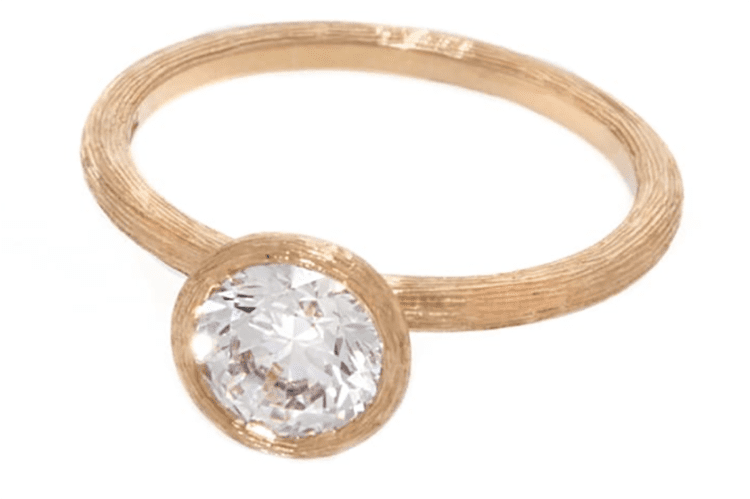
14K rose gold contoured twist tension set engagement ring. (Photo by James Allen).
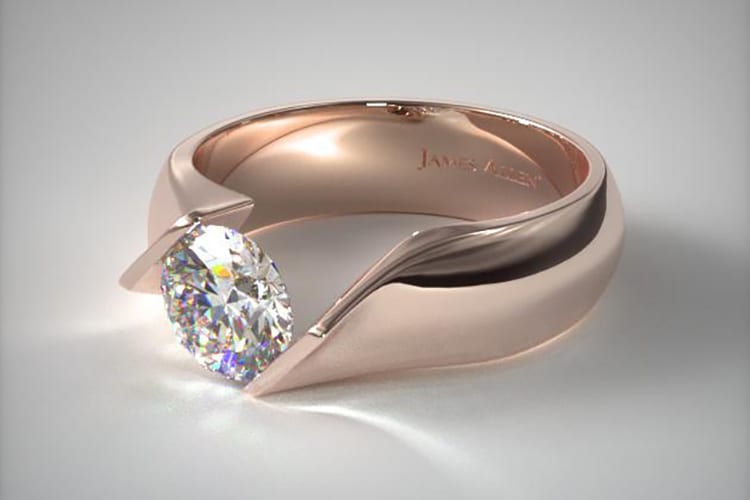
Timelessly Elegant
In short: Examples include emerald-cut set in prongs with a pavé diamond shank, marquise set east to west to give more coverage to the finger (or set north to south with a split pavé shank), three-stone rings of an Asscher with side baguettes, round diamond with pear shapes on shank or three round stones with larger center stone and smaller stones on the sides.
Examples: Greenwich St Ceremony Baxter 1.70ct diamond engagement ring. (Photo by Greenwich St Jewelers).
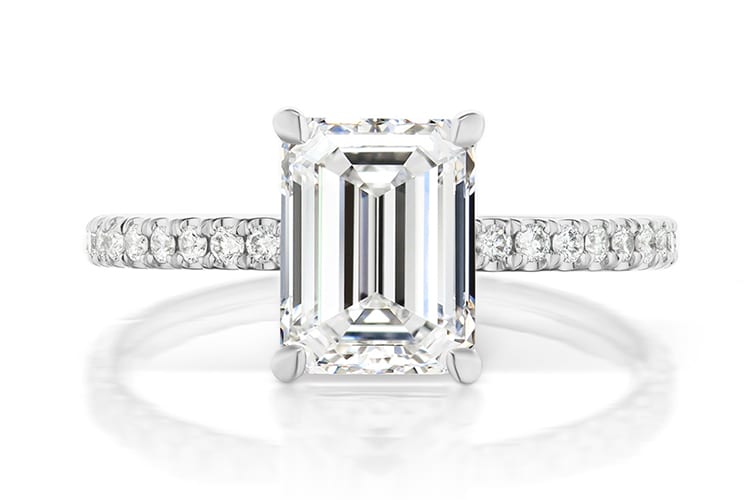
Sylvie bridal collection three stone engagment ring setting. (Photo by Greenwich St Jewelers).
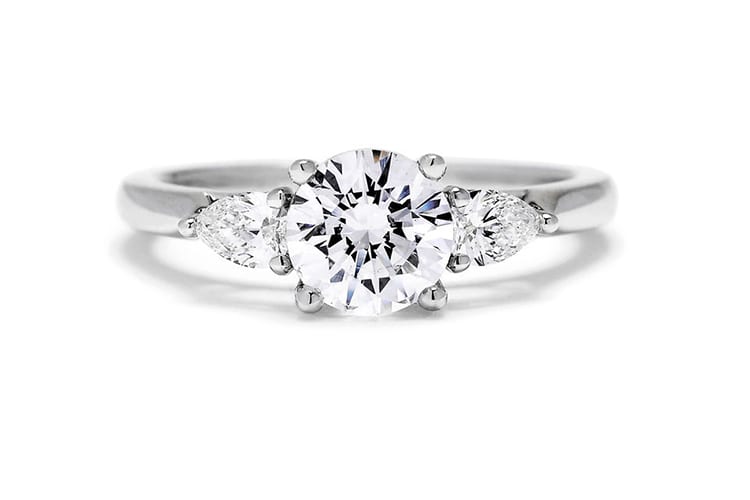
Natural vs Lab-Grown Diamonds (and All the Lookalikes)
When did humans finally figure out how to make diamonds using science? While lab-grown — in other words, man-made or synthetic — diamonds first emerged in the 1940s, 1955 is considered the breakthrough year. And these are not sneaky fakes; they’re chemically, physically, and optically the same as Earth-grown diamonds. For more on the topic, read our Guide to lab-grown vs mined diamonds.
Other names for lab-made diamonds: artificial, cultivated, synthetic diamonds, or cultured diamonds.
Pros: Lab-grown are considered eco-friendly and ethically sourced (minimizing environmental impact). They are often less expensive than earth-made diamonds.
Cons: There is still a stigma when you say it’s “lab-made.” Resale value may be less than that of an equivalent earth-made diamond.
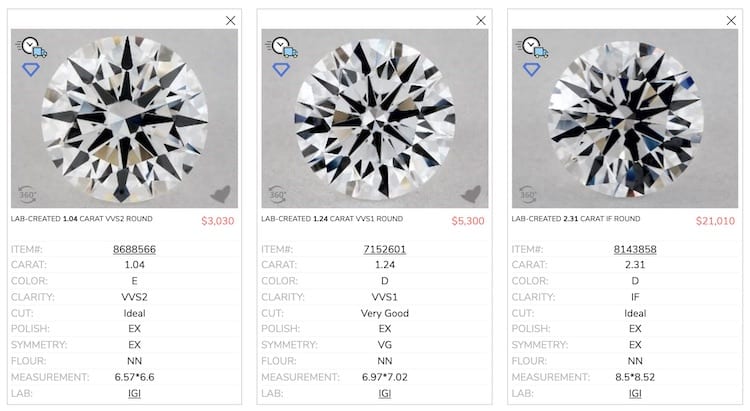
In another category are “diamond simulants,” which include cubic zirconia and moissanite. They may look like diamonds but they are not true carbon crystals.
Moissanite’s history dates back to the 1800s — and is largely popular because it’s less expensive than diamonds. But with both moissanite and lab-grown diamonds rising in price, it might not be as much of a savings as you have heard. See our Moissanite guide for more info.
Example:
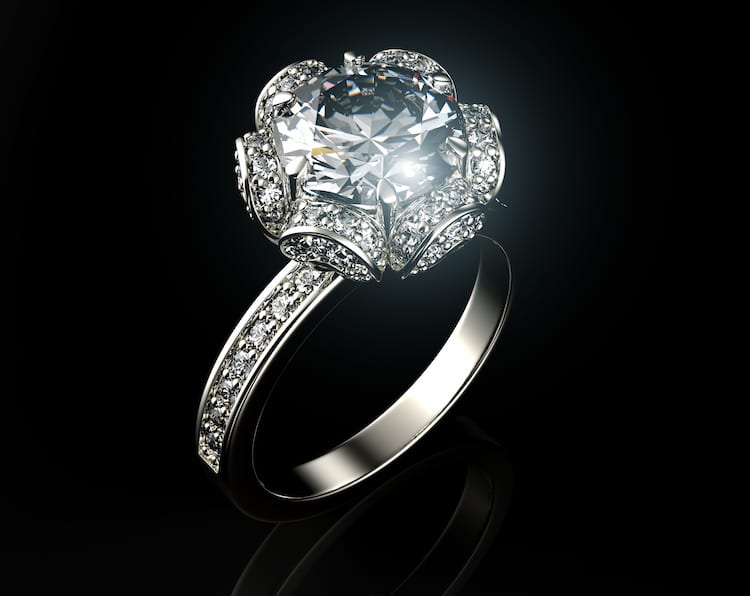
And then there is Cubic Zirconia (CZ), often mocked and rarely worn with pride. As a woman, I will tell you the only time I ever even considered a CZ ring was when I was younger and playing “here comes the bride with a fake groom and a fake ring. CZs are often put into settings in brick-and-mortar stores so that you can see how different diamonds would look on your finger in different settings. But they don’t plan on selling them that way. They will bring out different loose diamonds from which you can choose.
Crislu sterling silver round stone eternity band ring. (Photo by Bloomingdales).
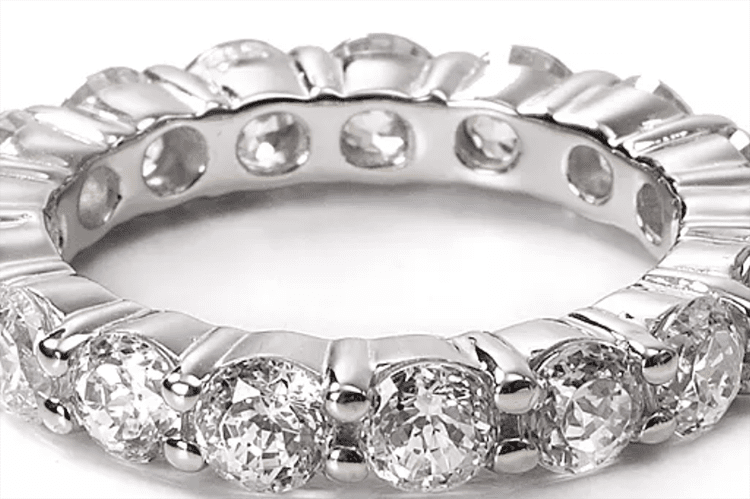
Frankly put: CZ does not symbolize an eternal bond. What message are you sending? That you haven’t thought this through and saved for the woman you want as your soulmate? Is that what you want to say? I don’t think so.
How Much Will It Cost?
How much does an engagement ring cost?
There is no magic number, no formula that delivers the perfect diamond ring budget for you. The old system was to spend two month’s salary, which you can still do, but this faded into oblivion like the two-martini lunch — especially since there are so many affordable styles and resources to choose from.
Go from zero to hero in five minutes: At James Allen or Blue Nile, you can adjust price ranges and other characteristics to see how many carats your budget buys. Their search tool is great. Their highly competitive pricing is too.
Here are some infographics from The Knot’s 2019 Jewelry & Engagement Study:
Ring Price Average in US
- Average cost of an engagement ring: $5,900.
- 33% of people spend $1,000 to $3,000 on their ring.
- 10% of shoppers spend under $1,000.
Ring Prices by Region
- The Mid-Atlantic: $7,500
- New England: $6,900
- Southwest: $5,600
- West: $5,500
- South: $5,400
- Midwest: $5,300
Diamond Shape & Ring Setting
- 83% choose diamond as center stone
- 50% of engagement rings are between one and two carats
- 50% of all rings were round cut
- 25% featured a halo.
Below are four key questions to consider when deciding on your budget.
1. What size stone does she want (if you are choosing with her or having one of her friends help)?
A one-carat diamond is popular and they can be had for a few grand.
2. What shape, setting, and style of ring will match her wish list (and which criteria can you play around with when it comes to the 4Cs)?
The safest bet would be a solitaire round brilliant diamond ring in a bezel or prong setting. Many people say “cut” is the most important of the 4Cs since it affects how much light passes through the diamond and creates dazzle.
3. How soon after your engagement do you plan on scheduling the big day?
Pundits say that most couples leave 13 months between getting engaged and married. Obviously, you could wait 13 minutes or 13 years, too.
4. Do you want a honeymoon, an apartment or home, and/or children relatively quickly?
If yes, then buying the ring without going into debt is very important as you plan your life together. How much you earn, how much she earns, and how you apply that should figure into your budget for the ring, too. It shouldn’t be a financial commitment that will burden other important things to come. You want it to be her dream ring, but you want her to be able to wear it while she’s living the best life with you.
That said, check out our diamond hacks guide, which includes several ways to cut costs when engagement ring shopping. Also peruse our married-couple finance primers (in the money section).
How to Pay: Cash, Loans & Credit Cards
You must realize that how you pay for the ring says a lot about who you are, how smart you are, and what you can offer a spouse in the future. So take a moment to consider the options.
First, when you take out a loan, you will be paying interest. This adds cost. You are trying to avoid cost. Similarly, many jewelry stores and jewelry sites have financing options but you’ll want to pay off the ring before you’re knee deep in interest, which will raise the ring’s cost considerably.
If you can transfer or open a new 0% APR promotional credit card account and can pay the ring off within the promotional period, this is an option you should consider. But be sure, once again, to pay off the ring before the term ends.
Many stores have their own financing policies. James Allen offers no interest on a purchase of at least $1,000 paid within six months. They have a second option, too: You can pay in 24 monthly installments with 9.9% APR on a purchase of at least $2,000. Check with salespeople at whatever company you visit; they may be open to more creative solutions, too.
Credit cards might also make sense. But it’s a smart idea if, and only if, you don’t have debt already and you can pay off the bill within a month to avoid interest charges. We have a whole dedicated guide explaining which ring-shopping credit cards to consider. Some have purchase protection, but you have to read the fine print. Other cards may offer big bonus points when you sign up (sort of like getting a free airline ticket).
Two things NOT to do: Don’t be persuaded into opening a jewelry store credit card (it’s never a better deal than getting a legit credit card). And don’t use a card with foreign transaction fees (which means you should not splurge in a jewelry shop 5,000 miles away, no matter how awesome the ring is).

When: Best Times of Year to Buy
Although diamond rings don’t necessarily go on sale, there are optimal times to get the best deals.
“Try not to shop around holiday season as this is when the stores and sites sell the most engagement rings — around Thanksgiving and going through Christmas time and sometimes even up to Valentine’s Day,” says Shaddaie. “But Black Friday and Cyber Monday are okay times because companies really do offer sales on fine jewelry and that often includes engagement ring settings.”
Summer is the best time to buy as this is the slow season for both brick-and-mortar and online stores. There are often savings — discounts or promotions — during this period, particularly on the settings and styles of the rings (the non-diamond parts).
Where: Physical Stores vs Online Shops
We spell out the pros and cons of shopping at brick-and-mortar shops vs websites. Let’s start with the physical stores:
In-Store Pros:
- You get to work closely with a live person who is often GIA-certified, knowledgeable, and professional — assuming you’ve done your background research on the store.
- You can see different styles of rings and diamonds up close and personal (no 3-D technology will rival the real deal in-person viewing). And if you’re shopping with your bride-to-be, she can try on many styles at once and see how they look — and FEEL — on her finger.
- If you go to a jeweler who has a design studio or works closely with designers who can create one-of-a-kind designs, you can have a ring made to your exact specifications, choosing a little from one style and the diamond shape from other style, etc.
In-Store Cons:
- Trustworthy neighborhood fine jewelry stores, with the best customer service and educated salespeople, might have a gorgeous selection but won’t have close to the inventory that an online store can provide.
- Brick and mortar shops can rarely beat websites on price due to the overhead of owning a store.
Online Pros:
- A vast selection, like hundreds of thousands of styles, settings, and diamonds at different price ranges. These stores don’t have the overhead that brick and mortar shops do, so you get to sift through seemingly endless choices.
- Better prices, somewhere between 20-50% lower than shopping at your neighborhood store.
- If the online shop has a home-viewing program, even better. You put the ring on your credit card and the site sends it to you to try on in your own home where you can then examine it and decide if it’s right for you. It’s even less pressure than at a store because no one is breathing down your neck to make the purchase.
- There are also programs where you can see the ring on your finger from every angle. Sofiakaman.com offers this on her website in the “My Treasure” section.
Online Cons:
- If they don’t have the lending policies to try out a ring in person, you will have to pull the trigger with an online purchase. Just make sure you understand the return policy.
- Even though you went to a reputable site, the ring might not look as good as it did it in photos.
- Overwhelming selection: It’s a double-edged sword to have hundreds of thousands of options. You may always wonder if you could have found a better diamond, a bigger diamond, or a clearer diamond.
See our complete guide to online vs brick-and-mortar stores.
Refunds & Warranties: Getting Money Back
Both online and brick-and-mortar stores have warranties, guarantees, return policies, and trade-in policies. You should know what’s standard before you make the purchase. Here are some common offerings:
Refunds should include:
- A money-back refund after 30 days if you’ve lived with the ring for a while and don’t like it (and haven’t damaged it). Note that sometimes you only get store credit.
- A no-questions-asked return policy. Sometimes pre-existing conditions alter what’s returnable.
Note: If the ring is one of a kind, you have approved all processes along the way, and the ring has been finalized, you will not be able to return it or get a refund. Here’s a list of what is NOT refundable from Blue Nile (quoted directly from the site):
- Engraved jewelry items other than rings may not be returned. All Blue Nile engraved rings may be returned for credit, however engraving fees are non-refundable. Removal of Blue Nile engraving from any exchanged or resized ring is free with no additional engraving fee.
- Diamonds purchased as part of our Blue Nile Diamond Upgrade Program may not be returned for credit, but can be exchanged within 30 days.
- Special orders are final sale and are not eligible for return or exchange.
- Shipping fees are non-refundable.
- Returns without a Blue Nile Return Merchandise Authorization will be refused upon receipt. Returns with missing paperwork or product will not be processed.
Warranties should include…
There are a few types of warranties:
a one-year warranty, which any store should offer. Parade Design spells out a one-year warranty here and Gabriel & Co. has one, too.
or
a lifetime warranty, which usually means you can trade in the ring for the same value or a higher value ring. This is something more and more stores are offering if the diamond is of a certain value and carat weight. Note that Blue Nile and James Allen offer a lifetime warranty.
Here’s what James Allen includes in its warranty (directly quoted from site):
- We are committed to ensuring the quality of your purchase; we stand behind everything that we sell and warrant that all items will be free from any manufacturing defects at the time of delivery. We will repair and maintain your jewelry for a lifetime.
- All of our jewelry is manufactured using the highest quality materials and is inspected prior to shipment. Our lifetime warranty offers free prong tightening, re-polishing, rhodium plating and cleaning services.
- To take advantage of these services, you can either mail your jewelry to our offices, or you can take it to a qualifying Jared service center to receive complimentary jewelry maintenance and repairs. Click here to learn more information and find a location near you.
- In the event that there is ever a problem with your jewelry or you are in need of other services that are not covered under our lifetime warranty, your jewelry can be mailed back to our office for evaluation*. Once inspected, should charges apply, you will be notified prior to any work being done to service your jewelry.
- Please Contact Us if you have any questions or would like to return your item(s) to take advantage of our free lifetime warranty or request additional repair work needed to service your James Allen jewelry.
- *To send us your ring, U.S. customers may purchase a fully insured shipping label for $30. International customers will be subject to return shipping cost applicable to their order. We will ship your item back to you free of charge.
Appraisals: What It’s Really Worth
Take the time and money to go to an outside appraiser for peace of mind (a second opinion — even if the diamond in the ring comes with certification) and for insurance purposes. If your jeweler is the appraiser, you’re not getting a second opinion.
The store or online site might seem trustworthy, but it’s always wise to have a formal piece of paper with the stats of the ring, not just the diamond that comes with the GIA, EGL, or AGS certificate. You need an appraisal that establishes the value of the ring for insurance.
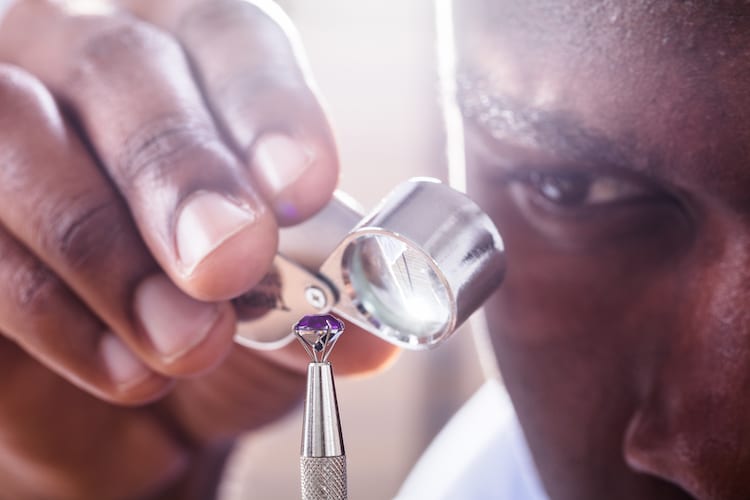
Tip: Get recommendations from friends and relatives who have used appraisers before. You should ask if you can be there when the appraisal is done because then you can ask a lot of questions and see everything that they are looking at to educate yourself.
Where to start? Gail Levine is an appraiser who is well known in the industry; she was executive director of The National Association of Jewelry Appraisers (NAJA), the largest membership association specializing exclusively in gem and jewelry appraising and related appraisal issues. She has a list of other well respected appraisers that you might be able to find in your area. For more info visit her website.
Insurance: Yes, You Need It
Here are nine things you need to know.
1. How soon should I insure after purchasing the ring?
Within 14 days.
2. What are the different ways to insure your ring?
You can purchase insurance through a company that specializes in jewelry insurance, like Jeweler’s Mutual or State Farm, which offers separate “valuables policies.” And if you have a homeowner’s or renter’s insurance policy, you can obtain a rider that will cover the engagement ring. It is best to get a rider that covers “itemized” or “scheduled” personal property rather than the blanket coverage of your basic homeowner’s policies.
3. Is one type of insurance better than another?
It is impossible to say which is best: homeowners/renter’s insurance with riders or a dedicated valuables policy from a jewelry insurance company. You need to find out exactly what kind of coverage you’re getting—and this depends on your location, the value of your stuff, whether you have a doorman or a safe and if you’re paying a deductible or not.
4. What are some good questions to ask?
- What is the ring insured for: lost, theft, or damage? Does the policy cover all three without exceptions? How about “mysterious loss”?
- If you’re insured for a replacement (not cash), where can you go to purchase a new ring?
- Will you receive the value of the ring as per the most recent appraisal or will insurance only cover the purchase price?
- What types of damages are you covered for? A scratch may not count.
- Can you choose the store or jeweler who repairs your ring?
- What happens if a reasonable replacement can’t be located?
- How will you prove the ring is really missing when you make a claim?
- Are there any situations where rings aren’t covered?
- Does the insurance extend to when you leave the country?
- What about inflation? Does that get factored in?
- Will you see your rates go up annually after you’ve made a claim?
5. What do you need to insure your ring?
Three key things:
- A professional appraisal.
- Photos of the ring from the jeweler where you bought it.
- A GIA certificate if there is one for your center diamond.

6. What needs to be on the appraisal?
It should include:
- Information about the 4Cs of the diamond (cut, clarity, carat, and color)
- Attributes and aspects that might look different in person then on the GIA report
- Ring metal
- Qualities of the center diamonds and/or colored stones
- Identifying characteristics such as hallmarks and modern designer marks
7. How does the insurance company determine the insurance cost on the ring?
Insurance companies take into consideration whether there is a deductible or not. Policies without deductibles will have higher premiums. But a formula is that the insurance cost for the ring will be between $1 and $2 per every $100.
Example: A $3,000 ring would be covered for $30-60 per year.
8. Are there any other ways to reduce the cost of insurance?
Yes! Having a doorman, security system, and/or a safe in your house or apartment may help.
9. What to do if you ever have to file a claim?
You will need to file a police report. Once the claim is opened, the insurance company will ask you for all the supporting documents such as your receipt for the ring, recent appraisals, GIA certificates, and photos. They will assign an adjuster to your case. The more information and documentation you provide, the smoother and the quicker you can shop for a new engagement ring. The process can take anywhere from only one week with some insurance companies to a month.
Read more about diamond and ring insurance.

